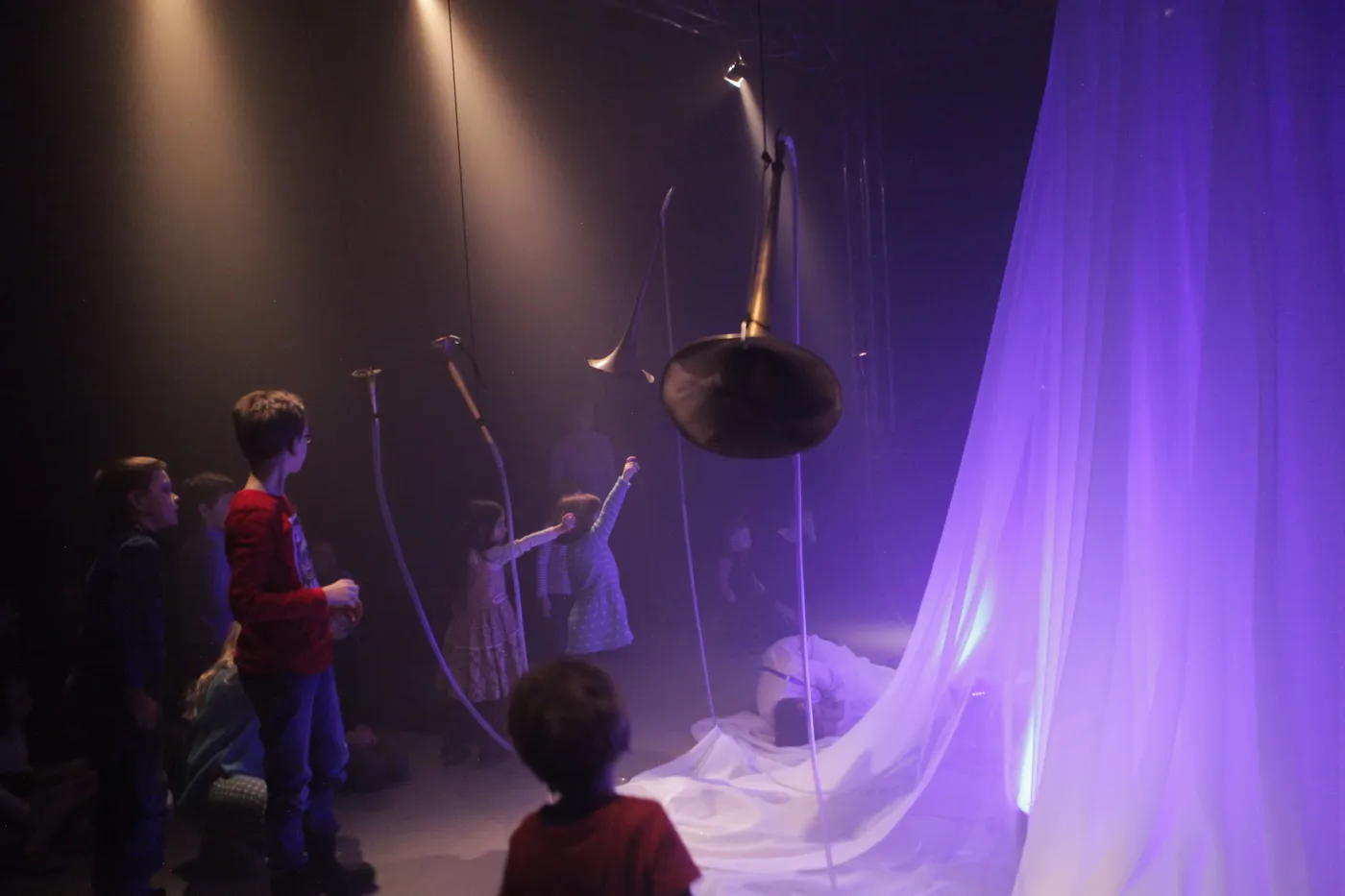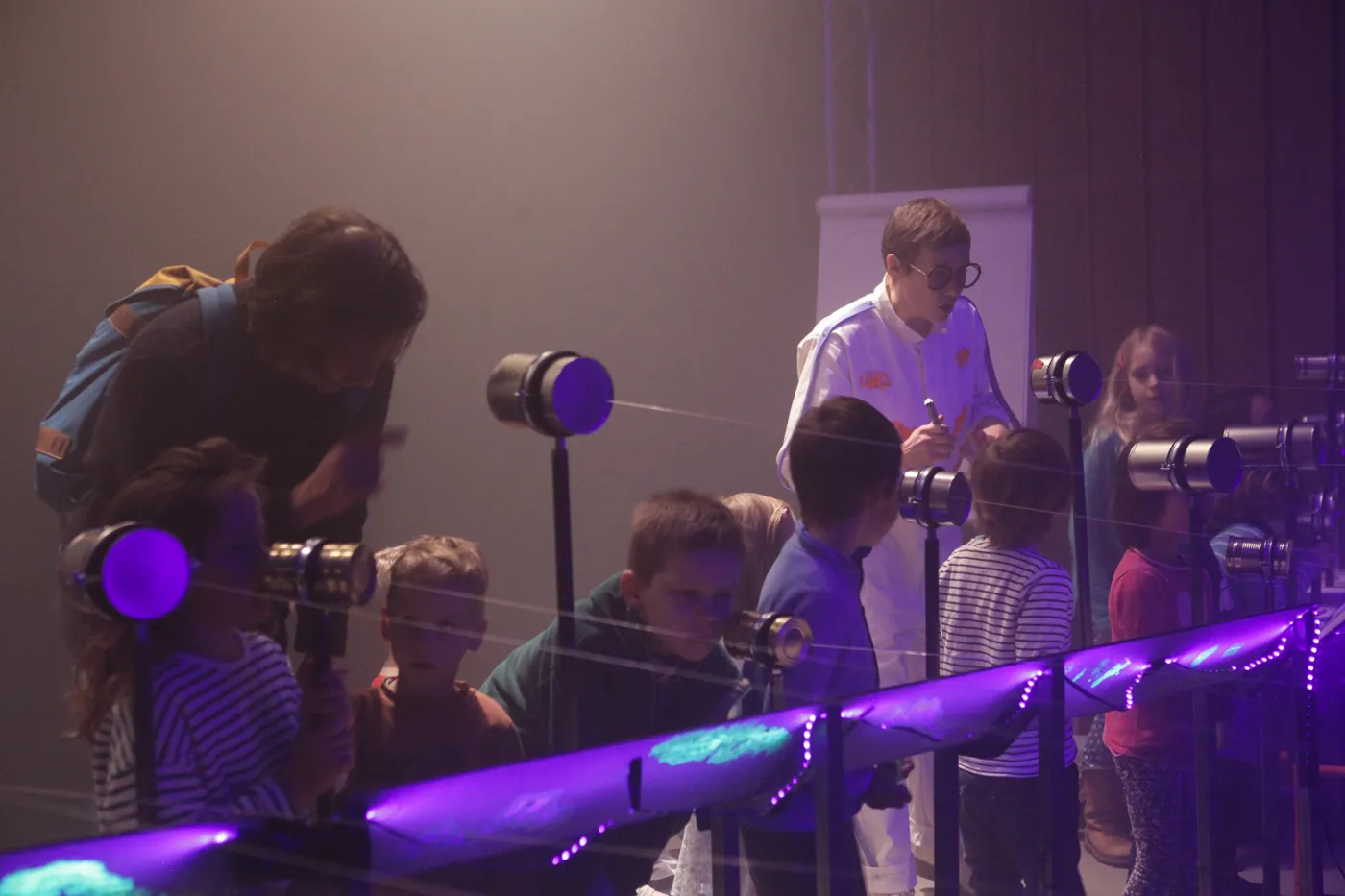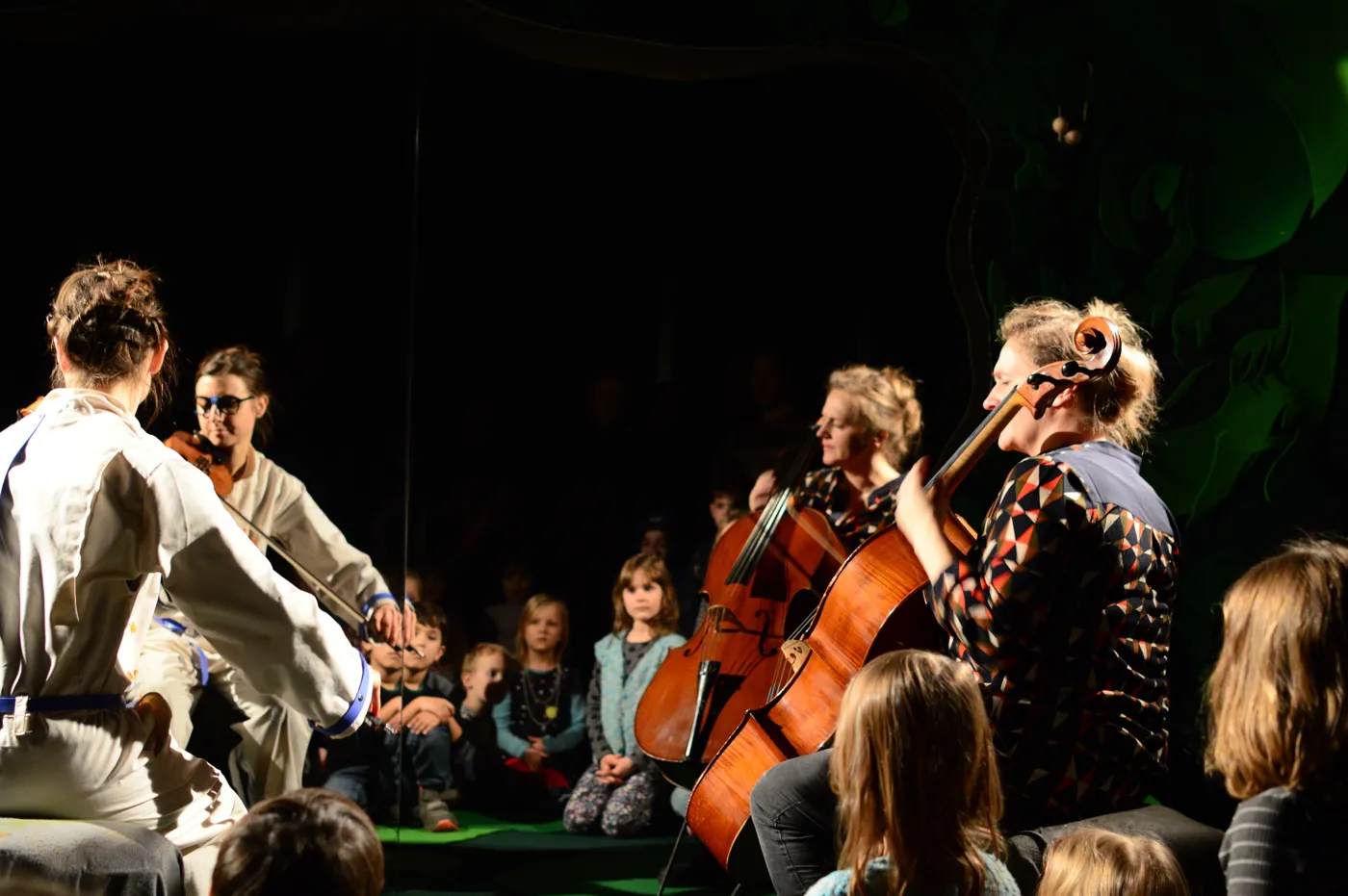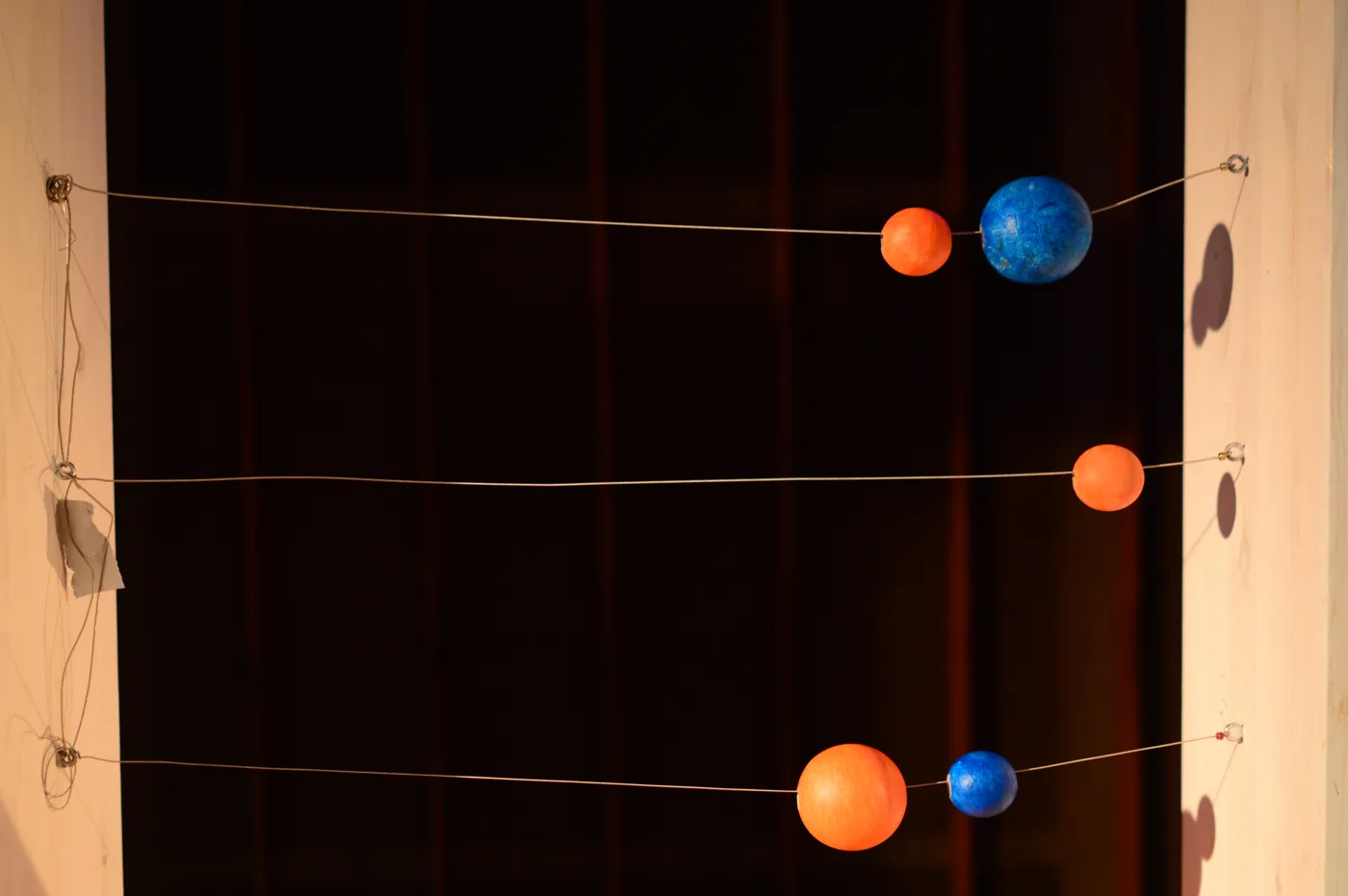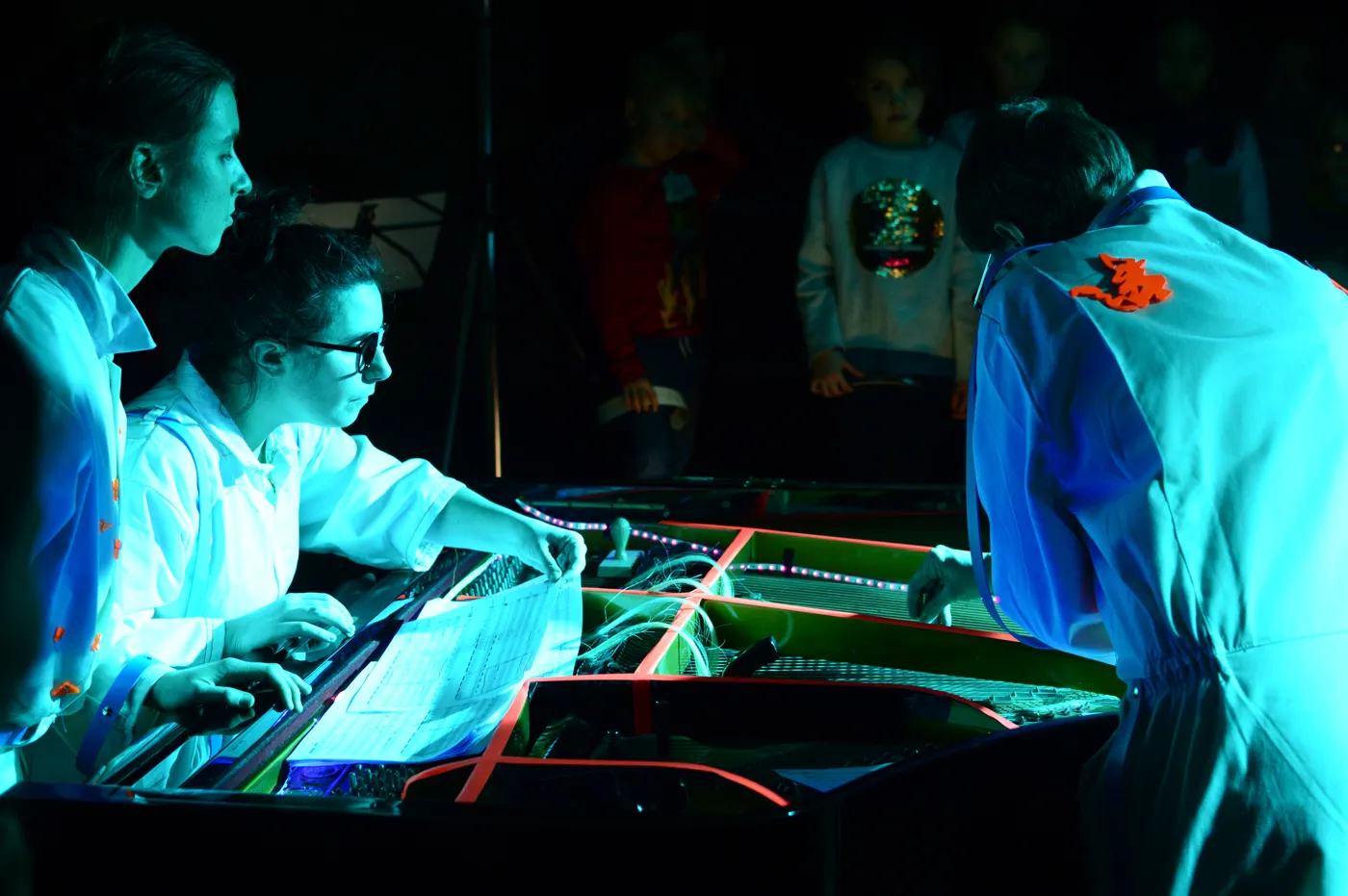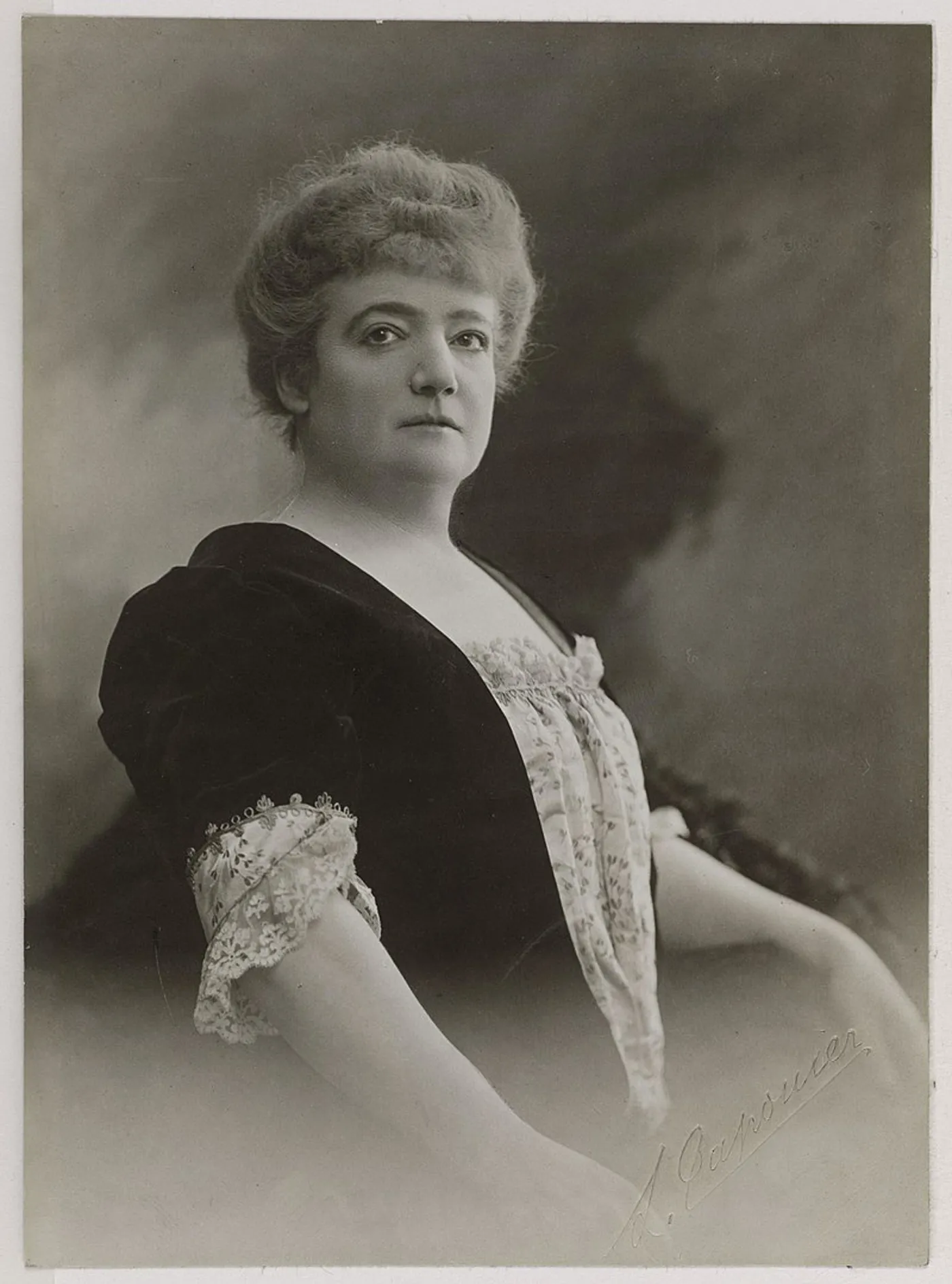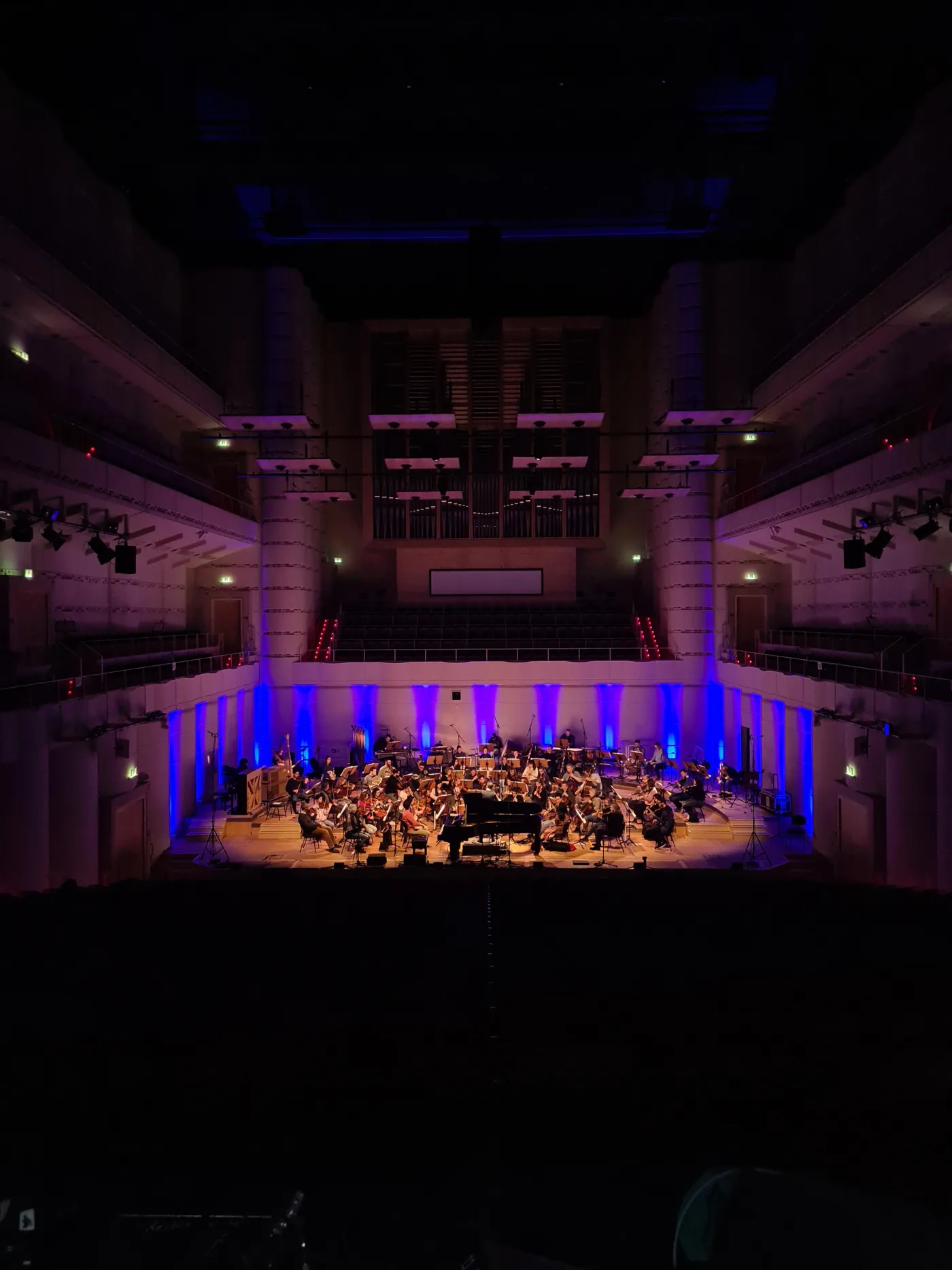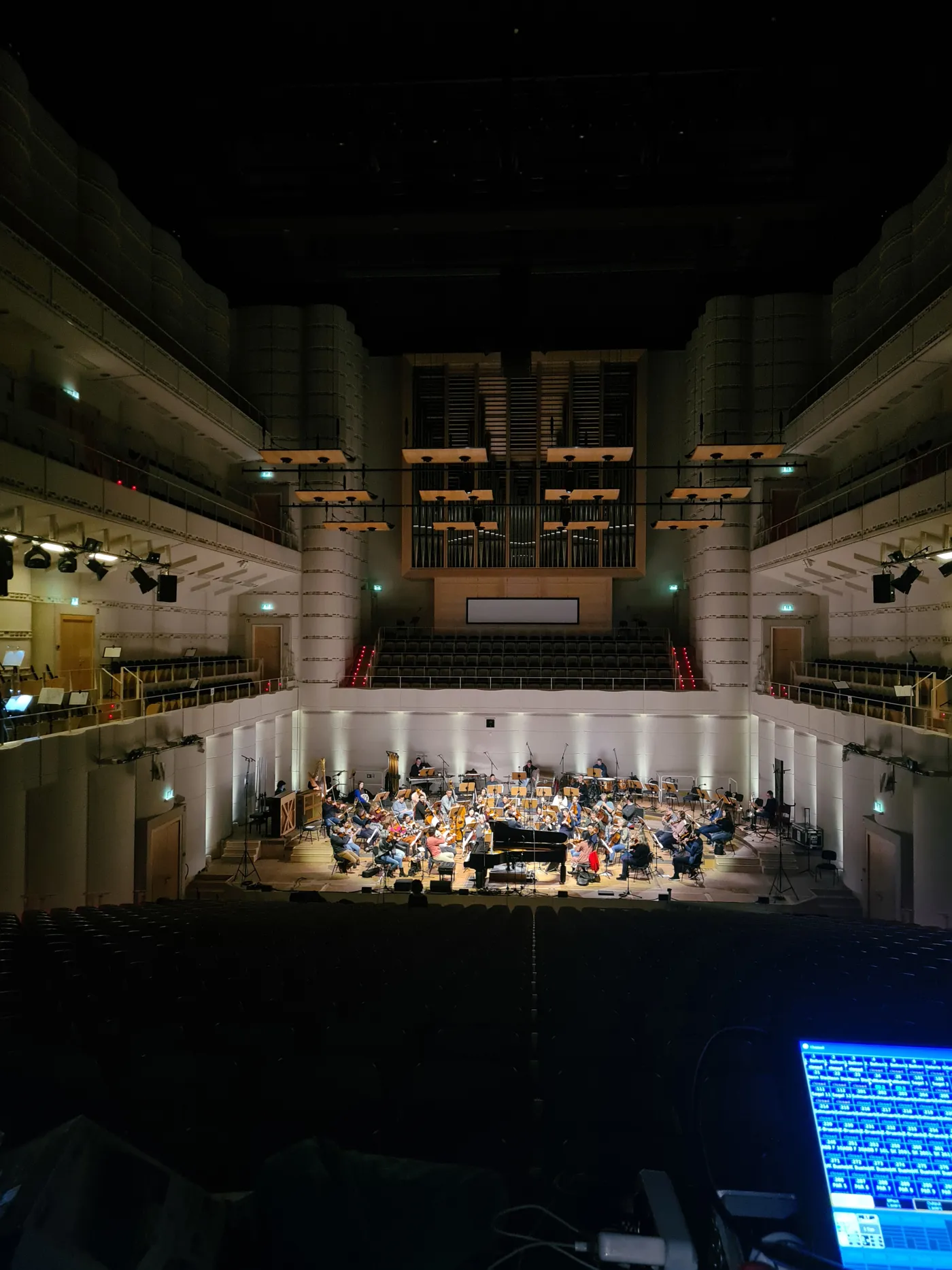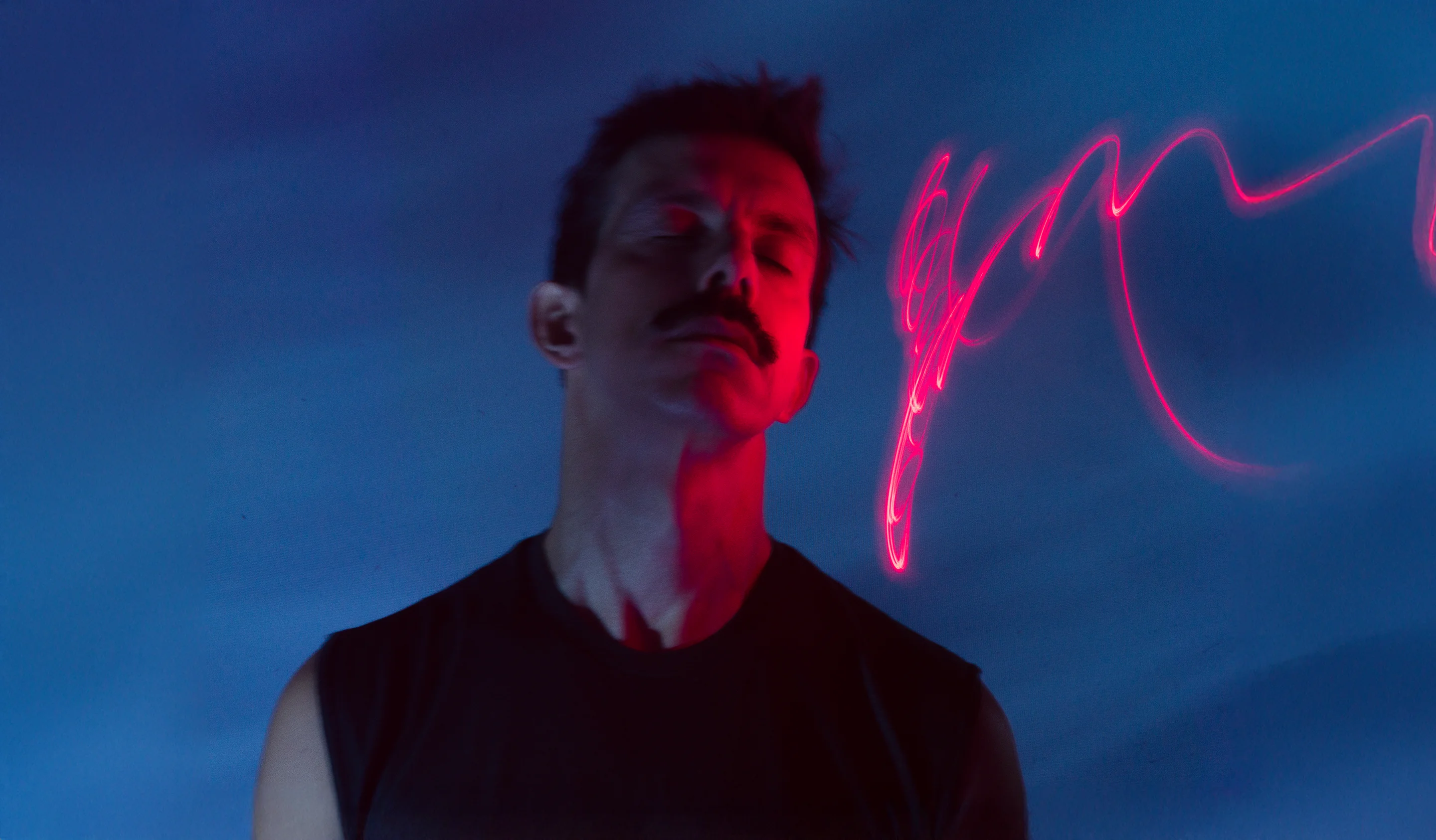
Where Orchestra and Audience finally meet
What if a concert allowed the orchestra and audience to engage — and not just physically share a space?
Inside the Orchestra (ITO) is a flexible concert format that transcends typical orchestral performance, inviting the audience to connect personally and playfully with the musicians, the music, and each other.
Rather than proposing a fixed model, this project offers a modular toolbox for the development of your own version of a concert that will foster meaningful connections between the stage and the seats. As such, it can be adapted to a wide range of settings — family concerts, subscription evenings, and special events. The goal is to break down the barriers that traditionally separate the public from the orchestra, transforming listeners from passive observers into active participants.
The concert is structured in two 45-minute concert halves, each with a different focus:
1 - "the orchestra introduces itself" features two works: Anatomy of an orchestra is a 24' performative introduction to the orchestra, that presents the musicians as individuals, with humor, rhythm, and theatrical flair — based on short interviews conducted before the concert (excerpt below). This piece is then followed by a repertoire piece of the orchestra’s own choosing, allowing for a musical introduction after the more personal, human one.
2 - the audience takes the lead: After the audience fills in a questionnaire in the intermission (with general questions about them, some questions the musicians answer in the first half, they send in questions for the musicians...), we enter the second half. For this part the program is usually reduced to smaller ensembles (chamber music, or splitting the orchestra into sections) and the interaction with the audience is much more pronounced. On the one hand, they decide the order of the musical program based on poetic descriptions by a representative musician of each of the works, and then the form of the concert alternates these works with commentary and games that derive from the questionnaire they filled. The audiences are introduced to themselves (this is who is here today, from these places, with these preferences), their answers shape up some occurrences on stage (for example, a Thomas Tallis Choral is played with the audience's four most beloved orchestral instruments) and generally speaking the communication between stage and audience takes more of a center stage, opening up communication channels that are usually kept shut in regular orchestra concerts.
Cuando la orquesta y el público finalmente se conocen
¿Qué pasaría si un concierto permitiera que la orquesta y el público interactuaran, y no solo compartieran físicamente un espacio?
Inside the Orchestra (ITO) es un formato de concierto flexible que trasciende la típica actuación orquestal e invita al público a conectar de forma personal y lúdica con los músicos, la música y entre ustedes mismos.
En lugar de proponer un modelo fijo, este proyecto ofrece una caja de herramientas modular para desarrollar una versión del concierto propia que fomente conexiones significativas entre el escenario y las butacas. Como tal, se puede adaptar a una amplia gama de entornos: conciertos familiares, veladas de abono o eventos especiales. El objetivo es romper las barreras que tradicionalmente separan al público de la orquesta, transformando a los oyentes de observadores pasivos en participantes activos.
El concierto se estructura en dos partes de 45 minutos, cada una con un enfoque diferente:
1 - «La orquesta se presenta» incluye dos obras: Anatomía de una orquesta (24') es una introducción performativa a la orquesta, que presenta a los músicos como individuos, con humor, ritmo y un toque teatral, basada en entrevistas a los músico realizadas antes del concierto (presento un fragmento en vídeo más abajo). A esta pieza le sigue una pieza de repertorio escogida por la propia orquesta, que les permite presentarse musicalmente después de la presentación más personal y humana.
2 - El público toma la iniciativa: una vez el público rellena un cuestionario en el intermedio (donde contestan preguntas generales sobre ellos, algunas preguntas que los músicos responden en la primera parte, envían preguntas para los músicos...), entramos en la segunda parte. Para esta, el programa suele reducirse a conjuntos más pequeños (música de cámara o secciones orquestales, por ejemplo) y la interacción con el público es mucho más pronunciada. Por un lado, ellos deciden el orden del programa musical basándose en descripciones poéticas de las obras por parte de un músico representante de cada una de ellas, y la forma del concierto alterna estas obras con comentarios y juegos que se derivan del cuestionario que han rellenado. Se presenta al público a sí mismo (quiénes estamos aquí hoy, de qué lugares venimos, cuáles son nuestras preferencias), y otras respuestas dan forma a algunos acontecimientos en el escenario (por ejemplo, se toca un coral de Thomas Tallis con los cuatro instrumentos orquestales preferido por el público) En general, la comunicación entre el escenario y el público cobra más protagonismo, abriendo canales de comunicación que normalmente permanecen cerrados en el concierto orquestal.
Wo Orchester und Publikum endlich zusammenkommen
Was wäre, wenn ein Konzert es dem Orchester und dem Publikum ermöglichen würde, miteinander in Kontakt zu treten – und nicht nur physisch denselben Raum zu teilen?
Inside the Orchestra (ITO) ist ein flexibles Konzertformat, das über die typische Orchesteraufführung hinausgeht und das Publikum dazu einlädt, persönlich und spielerisch mit den Musikern, der Musik und untereinander in Kontakt zu treten.
Anstatt ein festes Modell vorzuschlagen, bietet dieses Projekt eine modulare Toolbox für die Entwicklung einer eigenen Konzertversion, die sinnvolle Verbindungen zwischen Bühne und Zuschauerrängen fördert. So lässt es sich an eine Vielzahl von Settings anpassen – Familienkonzerte, Abonnementabende und Sonderveranstaltungen. Ziel ist es, die Barrieren zu überwinden, die traditionell das Publikum vom Orchester trennen, und die Zuhörer von passiven Beobachtern zu aktiven Teilnehmern zu machen.
Das Konzert besteht aus zwei 45-minütigen Hälften, die jeweils einen anderen Schwerpunkt haben:
1 – „Das Orchester stellt sich vor” umfasst zwei Werke: Anatomy of an orchestra, eine 24-minütige performative Einführung in das Orchester, die die MusikerInnen als Individuen mit Humor, Rhythmus und theatralischem Flair präsentiert – basierend auf kurzen Interviews mit den MusikerInnen (Videoauszug unten). Auf dieses Stück folgt ein Repertoirestück, das das Orchester selbst auswählt, sodass nach der eher persönlichen, menschlichen Vorstellung eine musikalische Vorstellung folgt.
2 – Das Publikum übernimmt die Führung: Nachdem das Publikum in der Pause einen Fragebogen ausgefüllt hat (mit allgemeinen Fragen über sich selbst, einigen Fragen, die die Musiker in der ersten Hälfte beantworten, und Fragen, die sie an die Musiker schicken ...), geht es in die zweite Hälfte. Für diesen Teil wird das Programm normalerweise auf kleinere Ensembles reduziert (Kammermusik oder Aufteilung des Orchesters in Sektionen), und die Interaktion mit dem Publikum ist viel ausgeprägter. Einerseits entscheidet das Publikum über die Reihenfolge des Musikprogramms auf der Grundlage poetischer Beschreibungen jedes einzelnen Werks durch einen repräsentativen Musiker, und dann wechselt die Form des Konzerts zwischen diesen Werken und Kommentaren und Spielen, die sich aus dem ausgefüllten Fragebogen ergeben. Wir stellen dem Publikum das Publikum vor (das sind die Leute, die heute hier sind, aus diesen Orten kommen wir, diese Vorlieben haben wir), und manche ihrer Antworten beeinflussen das Geschehen auf der Bühne (zum Beispiel wird ein Chorwerk von Thomas Tallis mit den vier beliebtesten Orchesterinstrumenten des Publikums gespielt) Generell rückt die Kommunikation zwischen Bühne und Publikum mehr in den Mittelpunkt, wodurch Kommunikationskanäle geöffnet werden, die bei normalen Orchesterkonzerten normalerweise geschlossen bleiben.
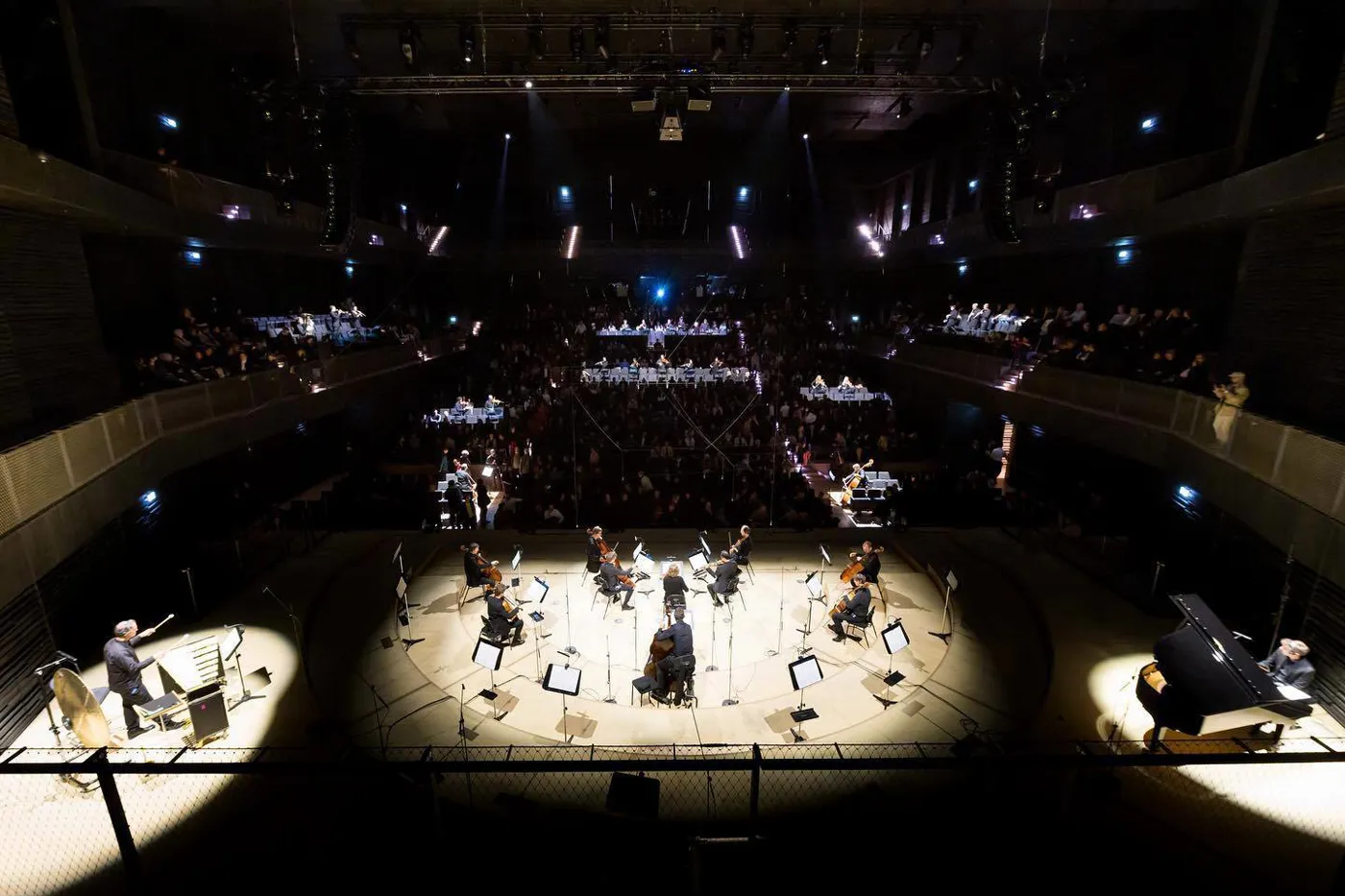
Ein#Klang took place in October 2021 to mark the opening of the Isarphilharmonie in Munich. It was a walk-in concert format in which visitors were guided through the entire building along winding paths—an opportunity to musically discover the new philharmonic hall, which was open to the public for the first time that week. The evening was designed by Iñigo Giner Miranda and Steven Walter in collaboration with the Munich Philharmonic Orchestra and students from the Munich University of Music and Performing Arts.
Excerpt from “Die Menschenfänger von Sendling” (The Pied Pipers of Sendling) by Egbert Tholl, published in the Süddeutsche Zeitung on October 11, 2021:
“In any case, around 1,000 people show up for Ein#Klang. No more are allowed in because the visitors, their faces of all ages lit up with the sparkle of children, are led along winding paths through all areas of the Isarphilharmonie.
The music begins in the foyer, then everyone sets off and encounters fragments of Gavin Bryars' piece “Jesus Blood Never Failed Me Yet" throught the building. They can be found in a wide variety of combinations, perfectly synchronized: in the connecting corridor, on stair landings, scattered in small groups throughout the hall itself. The journey there takes time because visitors keep stopping in amazement, or to take photos. Once inside the hall, Bryars's Klangkitsch increasingly reveals its intention to give a homeless man a poetic voice.
Then the incredibly precise and effective lighting design by Steven Walter and Iñigo Giner Miranda perfectly cuts a philharmonic string quartet on the podium out of the darkness, and the adagio from Schubert's string quintet resounds. With great tenderness, the five musicians prove what we already suspected after the opening concert: the Isarphilharmonie has immense potential as a chamber music hall. At the very front of the balcony, almost above the podium, you experience the perfect blend of harmony and analytical listening to each individual voice.
Then it's time to wander again, this time with the explicit invitation to do so projected onto the screen. While the musicians, scattered throughout the hall, play Terry Riley's intoxicating minimalist icon “In C,” the many curious visitors explore the sound of the hall, wander around, come very close to some of the musicians, and perhaps look for the seats they like best for the next concert. And everyone is almost reverent, spellbound. Many linger in the foyer for a long time afterwards, knowing they will return. We had expected a lot, but the overwhelming success of the Isarphilharmonie is truly astonishing."
Ein#Klang tuvo lugar en octubre de 2021 con motivo de la inauguración de la Isarphilharmonie de Múnich. Se trataba de un formato de concierto-paseo en el que los visitantes eran guiados por sinuosos caminos a través de todo el edificio, una oportunidad para descubrir musicalmente la nueva filarmónica, que abría sus puertas al público por primera vez esa semana. La velada fue diseñada por Iñigo Giner Miranda y Steven Walter en colaboración con la Filarmónica de Múnich y estudiantes de la Escuela Superior de Música de Múnich.
Extracto de «Die Menschenfänger von Sendling» (Los flautistas de Sendling), de Egbert Tholl, publicado en el Süddeutsche Zeitung el 11 de octubre de 2021:
«En cualquier caso, alrededor de 1000 personas acuden a Ein#Klang. No se permite la entrada a más, porque los visitantes, de todas las edades y con rostros iluminados por una ilusión infantil, son conducidos por intrincados recorridos a través de todas las zonas de la Isarphilharmonie.
La música comienza en el vestíbulo, después todos se ponen en marcha y van encontrando fragmentos de la pieza de Gavin Bryars «Jesus Blood Never Failed Me Yet» repartidos por todo el edificio en su largo camino a la sala. Se pueden encontrar en una gran variedad de combinaciones y perfectamente sincronizados en el pasillo que conecta, en los rellanos de las escaleras y luego dispersos en pequeños grupos por toda la sala. El trayecto lleva tiempo porque los visitantes se detienen continuamente, asombrados o para hacer fotos. Una vez dentro de la sala, el kitsch sonoro de Bryars revela cada vez más su intención de dar una voz poética a un vagabundo.
A continuación, el diseño de iluminación increíblemente preciso y eficaz de Steven Walter e Iñigo Giner Miranda recorta perfectamente de la oscuridad a un quinteto de cuerda filarmónico en el podio, y resuena el adagio del quinteto de cuerda de Schubert. Con gran ternura, los cinco músicos demuestran lo que ya sospechábamos tras el concierto inaugural: la Isarphilharmonie tiene un inmenso potencial como sala de música de cámara. En la primera fila del balcón, casi sobre el podio, se experimenta la mezcla perfecta entre la armonía y la escucha analítica de cada voz individual.
Luego llega el momento de volver a pasear, tal y como invita explícitamente la proyección en la pantalla. Mientras los músicos, repartidos por toda la sala, tocan la embriagadora obra minimalista de Terry Riley «In C», los numerosos visitantes curiosos exploran el sonido de la sala, deambulan, se acercan mucho a algunos de los músicos y quizá buscan los asientos que más les gustan para el próximo concierto. Y todos están casi reverentes, como hechizados. Muchos se quedan mucho tiempo en el vestíbulo después, sabiendo que volverán. Esperábamos mucho, pero el abrumador éxito de la Isarphilharmonie es realmente asombroso».
Ein#Klang fand im Oktober 2021 zur Eröffnung der Isarphilharmonie in München statt. Es handelte sich um ein begehbares Konzertformat, bei dem Besucher:innen auf verschlungenen Wegen durch das gesamte Gebäude geführt wurden – eine Gelegenheit, die neue Philharmonie, die in dieser Woche erstmals für das Publikum geöffnet war, auf klangvolle Weise zu entdecken. Gestaltet wurde der Abend von Iñigo Giner Miranda und Steven Walter in Zusammenarbeit mit den Münchner Philharmonikern und Studierenden der Musikhochschule München.
Ausschnitt aus „Die Menschenfänger von Sendling“ von Egbert Tholl, erschienen in der Süddeutschen Zeitung am 11. Oktober 2021:
"Auf jeden Fall kommen knapp 1000 Menschen zum "Ein#Klang", mehr dürfen nicht rein, weil die Besucher, mit leuchtenden Kinderaugen in Gesichtern jeglichen Alters, auf verschlungenen Pfaden durch alle Bereiche der Isarphilharmonie geführt werden.
Im Foyer beginnt die Musik, dann macht man sich bald auf den Weg und trifft immer wieder auf Partikel des Stücks von Gavin Bryars, "Jesus Blood Never Failed Me Yet". Man findet sie in unterschiedlichsten Besetzungen und perfekt synchronisiert im Zwischenkorridor, auf Treppenabsätzen und dann in Grüppchen verteilt überall im Saal selbst. Der Weg dort hinein dauert, weil die Besucher immer weder verblüfft stehen bleiben, Fotos machen. Drinnen rundet sich dann der Klang, aus Bryars Klangkitsch schält sich zunehmend das Anliegen heraus, einem Obdachlosen eine poetische Stimme zu geben.
Dann schneidet die ungemein präzise und effektvolle Lichtdramaturgie von Steven Walter und Iñigo Giner Miranda perfekt ein philharmonisches Streichquintett auf dem Podium aus dem Dunkel, es erklingt das Adagio aus Schuberts Streichquintett. Mit großer Zartheit beweisen die Fünf, was man nach dem Eröffnungskonzert schon ahnte: Die Isarphilharmonie hat ein immenses Potenzial als Kammermusiksaal. Ganz vorne auf dem Balkon, fast oberhalb des Podiums, erlebt man die perfekte Mischung aus Zusammenklingen und analytischem Hören jeder einzelnen Stimme.
Dann darf wieder gewandert werden, die explizite Aufforderung dazu wir projiziert. Während die Musikerinnen und Musiker im Saal verteilt Terry Rileys rauschhafte Minimal-Music-Ikone "In C" spielen, erkunden die vielen neugierigen Besucher den Klang des Saals, wandern herum, kommen manchem Musikanten sehr nah, suchen sich vielleicht die ihnen genehmsten Plätze fürs nächste Konzert. Und alle sind fast andächtig, gebannt. Viele bleiben danach noch lange im Foyer, werden wiederkommen. Man hat ja mit vielem gerechnet, aber dass der Erfolg der Isarphilharmonie so überbordend ist, das ist dann doch verblüffend."
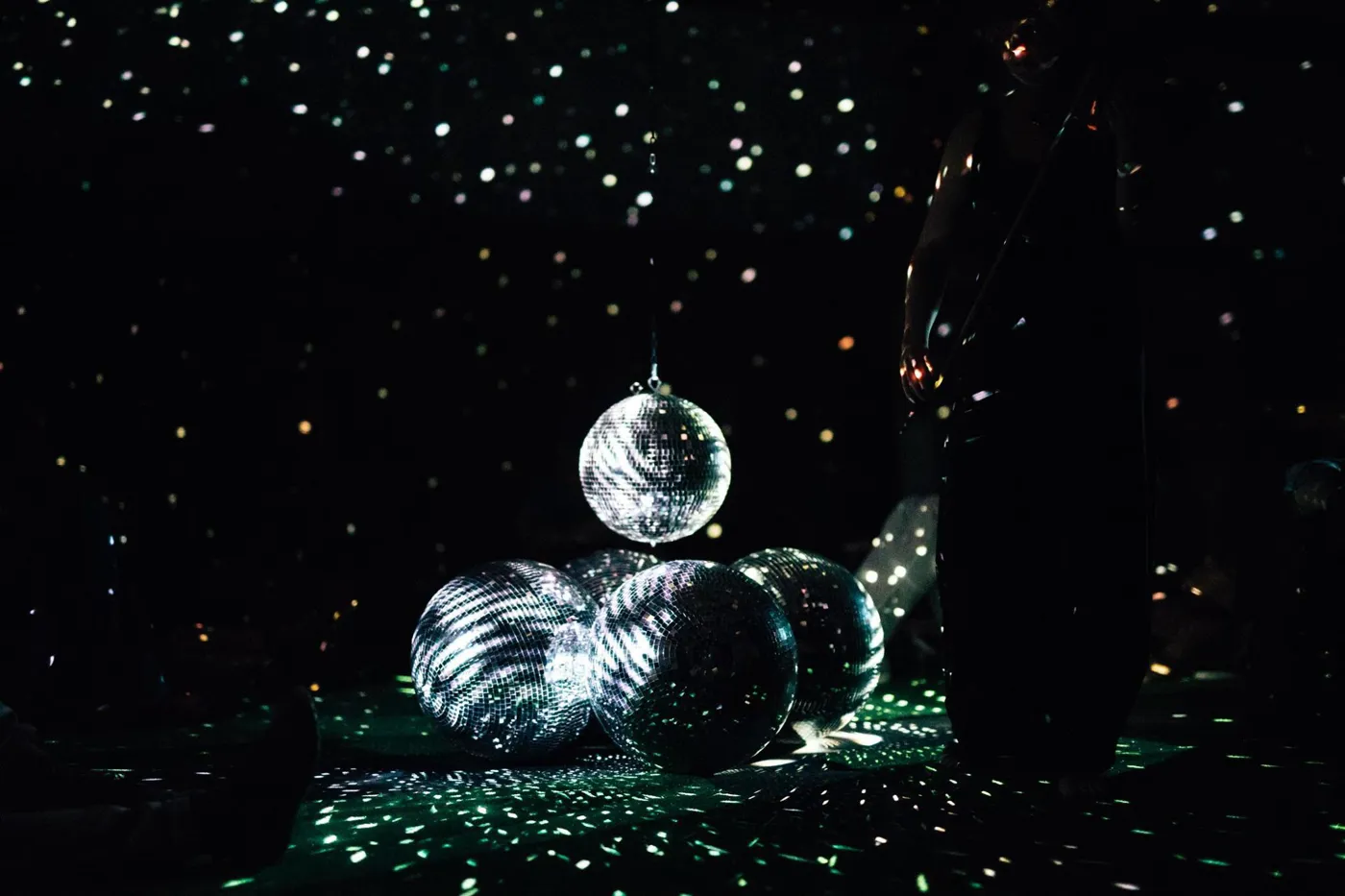
Do you remember spending hours in your childhood bedroom armed with blankets, pillows, old fabrics, bits of string, and any enchanted object you could find around in the house, building a cave? That magical moment when you finally climbed into that small space with your sister or a friend, and you were instantly transported to a completely different world
? The pleasant, musty smell of the attic, the feeling of the scratchy carpet under your knees or hanging cloths on your face. Despite being such cramped quarters, these caves opened up an incredibly vast world of imagination. Music can often do what cloths and pillows did back then: stir up deep emotions, tell ancient stories, and open up fantastic spaces—in abstract form.
In contrast, the actual spaces in which music is usually played rarely tell such stories. They are supposed to have excellent acoustics, be equipped with comfortable seating, and offer a good view of the stage so that the music can unfold its full effect. In (T)räume this was quite different. We dared to combine designed space and musical worlds, haptics and acoustics, visual appeal and beautiful sound.
Iñigo Giner Miranda (#bebeethoven fellow at the time) and set designer Àngela Ribera, together with dramaturge Wiebke Rademacher, are transforming Villa Nagel into a house of music. In Esslingen, scenographic means were used on various rooms to create a sort of sensorial resonance space for the music played in each room. They call on basic emotions such as curiosity, security, and the uncanny. Like children in the caves of their bedrooms, the audience was invited to immerse themselves directly in these musical worlds. To make this possible, they were split into three groups, along with a string quartet and a clarinetist, and eventually brought back together for the finale of this special event.
(T)räume offers magnificent chamber music from five centuries—in an atmosphere that this music has certainly never experienced before.
¿Recuerdas las muchas horas que pasabas en tu habitación infantil armado con mantas y almohadas, telas viejas, cuerdas y cualquier objeto "mágico" que encontrabas en casa para construir una cueva? ¿Ese momento en el que finalmente te metías con tu hermana o un amigo en esos pequeños espacios y de repente te encontrabas en un mundo completamente diferente? El agradable olor a humedad del desván, la sensación de la alfombra áspera bajo las rodillas y los paños colgando sobre la cara. A pesar de lo reducido del espacio, esos escondites abrían un mundo increíblemente vasto en la imaginación. Lo que hacían esos paños y esos cojines, también lo puede hacer la música: despertar sentimientos profundos, contar historias primigenias o abrir espacios fantásticos.
Por el contrario, los espacios reales en los que se suele presentar música clásica rara vez cuentan historias. Deben tener una acústica excelente, estar equipados con cómodos asientos y ofrecer una buena vista del escenario para que la música pueda desplegar todo su efecto en estado puro. En (T)räume todo esto es radicalmente diferente. Aquí nos atrevimos a combinar el diseño de un espacio y su mundo musical, el tacto, la acústica, el estímulo visual y sonido cristalino.
Iñigo Giner Miranda (becario de #bebeethoven en aquel momento) y la escenógrafa Àngela Ribera, junto con la dramaturga Wiebke Rademacher, transformaron la Villa Nagel en Esslingen en una cámara de música. Allí se crearon, mediante recursos escenográficos, habitaciones en diferentes plantas que actuaban como una resonancia espacial para la música que allí sonaba. Las habitaciones estaban creadas en torno a emociones muy básicas como la curiosidad, la seguridad y el misterio. Al igual que los niños en las cuevas de sus habitaciones, el público estaba invitado a sumergirse directamente en estos mundos musicales. Para ello, se dividía al público en tres grupos más pequeños e íntimos, y junto con un cuarteto de cuerda y un clarinetista experimentaban las habitaciones y finalmente se volvían a reunir.
(T)räume ofrece magnífica música de cámara abarcando cinco siglos, en un ambiente que esta música seguramente nunca ha visto antes.
Erinnert ihr euch noch an die vielen Stunden, die man mit Decken und Kissen, alten Stoffen, Schnüren und allen verzauberten Gegenständen, die man im Hause finden konnte, im Kinderzimmer verbrachte, um eine Höhle zu bauen?
Dieser magische Moment, wenn man schließlich mit der Schwester oder dem Freund in diese kleinen Räume kletterte und sofort in einer völlig anderen Welt war? Der angenehm muffige Geruch des Dachbodens, das Gefühl von kratzigem Teppich unter den Knien und herunterhängenden Tüchern im Gesicht. In aller Enge öffneten diese Höhlen doch eine unheimlich weite Welt der Fantasie. Was die Tücher und Kissen konnten, kann Musik oft auch: tiefe Gefühle hervorrufen, uralte Geschichten erzählen und fantastische Räume öffnen – in abstrakter Konkretion.
Dagegen erzählen die tatsächlichen Räume, in denen Musik meist gespielt wird, eher selten Geschichten. Sie sollen eine exzellente Akustik haben, mit komfortablen Sitzmöglichkeiten ausgestattet sein und einen guten Blick auf die Bühne bieten, damit die Musik ganz pur ihre Wirkung entfalten kann. Bei (T)räume ist das anders. Wir wagen die Verbindung von gestaltetem Raum und musikalischen Welten, von Haptik und Akustik, von visuellem Reiz und wunderschönem Klang.
Der #bebeethoven-Fellow Iñigo Giner Miranda und die Ausstatterin Àngela Ribera verwandeln zusammen mit Dramaturgin Wiebke Rademacher die Villa Nagel in ein Haus für Musik. Miranda und Ribera haben bereits in verschiedenen Projekten erfolgreich zusammengearbeitet, immer mit dem Fokus auf neue Formate der Musikdarstellung. Zuletzt arbeiteten sie zusammen am Haus der Kulturen der Welt in Berlin und entwickelten Bestiarium, einen interaktiven Klangspaziergang. Kleine und große Besucher*innen begegneten dort in einzigartigen Räumen verschiedenen Kreaturen aus der fantastischen Literatur.
In Esslingen wurden mit szenographischen Mitteln auf verschiedenen Etagen für die dort erklingende Musik sinnliche Resonanzräume geschaffen. Sie öffnen sich für ganz basale Emotionen wie Neugierde, Geborgenheit und das Unheimliche. Wie die Kinder in den Höhlen der Kinderzimmer ist auch unser Publikum eingeladen, unmittelbar in die musikalischen Welten einzutauchen. Um dies zu ermöglichen, wird es – und mit ihm ein Streichquartett und ein Klarinettist – in drei Gruppen geteilt, die schließlich wieder zusammengeführt werden.
(T)räume bietet großartige Kammermusik aus fünf Jahrhunderten – in einer Atmosphäre, die diese Musik bestimmt noch nie gesehen hat.
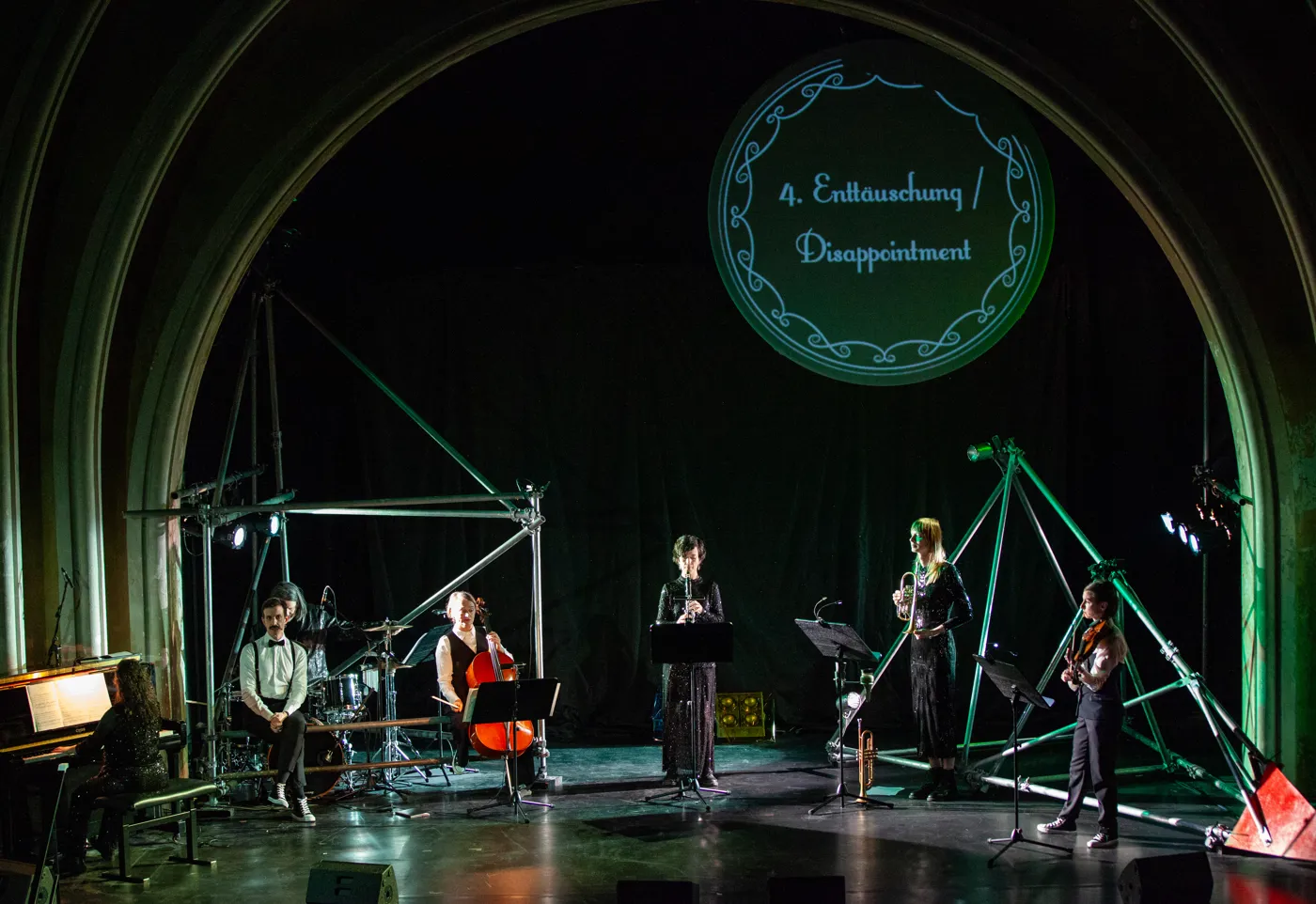
Cabaret concert about a time when we thought technology could save us
What does technological progress do to us—then and now?
Wireless to Heaven is a documentary musical theater piece about the history of technological progress and what it unleashes: closeness, fascination, control, community—and loneliness.
In “Wireless to Heaven,” the ensemble DieOrdnungDerDinge traces the curve that almost all technological innovations go through: from fascination and euphoria to skepticism and rejection, and finally to tacit integration into everyday life. Using the history of radio—from the first broadcasts to its political and private instrumentalization—the piece outlines a pattern that can be observed again today in our dealings with artificial intelligence. Archive material, original quotes, songs from the 1920s, radio poetry, and live music come together to create an evening full of humor, seriousness, nostalgia, and critical questions about the future emerges.
Music by Poulenc, Prokofiev, Hindemith, Eisler, jazz from the 1920s, and AI-generated texts and sounds merge with shadow theater, video projections, and a choral-performative ensemble to create an evening that short-circuits the past and the future— landing somewhere between Berlin wit and futuristic preaching.
"Wireless to Heaven" tells of a strangely familiar past that invites us to rethink our relationship with technology in our present.
Un concierto-cabaret sobre una época en la que creímos que la tecnología podría salvarnos.
¿Cómo nos afecta el progreso técnico, tanto entonces como ahora?
Wireless to Heaven es un teatro musical documental sobre la historia del progreso tecnológico y sus efectos en nuestra vida: cercanía, fascinación, utopía, comunidad… y también soledad.
En «Wireless to Heaven», el conjunto DieOrdnungDerDinge recorre la historia de la radio y narra la trayectoria que siguen casi todas las innovaciones tecnológicas: desde la fascinación y la euforia, pasando por el escepticismo y el rechazo, hasta su integración silenciosa en la vida cotidiana. A partir de la historia de la radio, desde las primeras emisiones hasta su instrumentalización política y privada, la obra traza un patrón que se puede observar hoy en día en el uso de la inteligencia artificial. Entre material de archivo, citas originales, canciones de los años 20, poesía radiofónica y música en directo, se crea una velada llena de humor, seriedad, nostalgia y preguntas críticas sobre el futuro.
Lo que comienza como un homenaje a la magia de las primeras emisiones de radio atraviesa el uso político de la radiodifusión, grabaciones de ruiseñores y recetas de cocina que flotan en el éter, hasta llegar a los asistentes de voz contemporáneos y la inquietante pregunta: ¿qué ocurre cuando las máquinas nos comprenden mejor que nosotros mismos?
Música de Poulenc, Prokofiev, Hindemith, Eisler, jazz de los años 20 y sonidos generados por inteligencia artificial se entrelazan con teatro de sombras, proyecciones de video y un conjunto coral-performativo. El resultado: una experiencia escénica que conecta pasado y futuro, entre el humor berlinés y el sermón futurista.
Wireless to Heaven invita a escuchar la radio de otra forma: como espejo de nuestros sueños y miedos tecnológicos. Narra un pasado extrañamente cercano, que nos impulsa a repensar nuestra relación con la tecnología.
Kabarettkonzert über eine Zeit, in der wir dachten, Technologie könne uns retten
Was macht der technische Fortschritt mit uns – damals wie heute?
Wireless to Heaven ist ein dokumentarisches Musiktheater über die Geschichte technologischer Fortschritt und das, was es auslöst: Nähe, Faszination, Kontrolle, Gemeinschaft – und Einsamkeit.
In „Wireless to Heaven“ folgt das Ensemble DieOrdnungDerDinge der Geschichte des Radios – und erzählt dabei von jener typischen Kurve, die fast alle technologischen Neuerungen durchlaufen: von Faszination und Euphorie über Skepsis und Ablehnung bis hin zur stillschweigenden Integration in den Alltag. Anhand der Geschichte des Radios – von den ersten Sendungen bis zu seiner politischen und privaten Instrumentalisierung – zeichnet das Stück ein Muster nach, das sich heute im Umgang mit Künstlicher Intelligenz erneut beobachten lässt. Zwischen Archivmaterial, Originalzitaten, Liedern der 1920er Jahre, Radiopoesie und Live-Musik entsteht ein Abend voller Witz, Ernst, Nostalgie und kritischer Zukunftsfragen.
Musik von Poulenc, Prokofjew, Hindemith, Eisler, Jazz der 20er und KI-generierte Texte und Klänge verschmelzen mit Schattentheater, Videoprojektionen und einem chorisch-performativen Ensemble zu einem Abend, der Vergangenheit und Zukunft miteinander kurzschließt – zwischen Berliner Witz und futuristischer Predigt.
„Wireless to Heaven“ lädt dazu ein, das Radio neu zu hören – als Spiegel unserer technischen Träume und Ängste. Es erzählt von einer Vergangenheit, die seltsam vertraut wirkt – und lädt dazu ein, unsere Beziehung zur Technologie neu zu betrachten.
-franzi-kreis-004.webp)
The artistic-scientific communication project Cabaret der alten Neuigkeiten (Cabaret of Old News) invited teenagers and young adults to critically reflect on historical knowledge and current events. In a participatory process, students from the De la Salle School in Strebersdorf, Vienna (teacher: Miriam Schmid) worked together with students from the MUK and an artistic-educational team consisting of director Iñigo Giner Miranda, Prof. Wiebke Rademacher, and scenographer Angela Ribera. Together they created a collage theatre show in cabaret style that intertwined original texts and image sources with music from the period between 1918 and 1933, while questioning their relevance today. During the process, the project participants identified social parallels between the 1920s and 2020s – from global pandemics and fake news to feminist demands and concerns about rising populism.
The development process included workshops and seminars in which school and university students were able to immerse themselves in the original sources and conduct their own research. Additional students from all over Vienna were invited to the five final performances at Dschungel Wien, some of them also having the opportunity to learn about the project's working methods and sources in accompanying workshops. In addition, the project results were made available to a broad public in digital form. The project drew on methods from citizen science, community music, peer education, and documentary theater. It was based on the hypothesis that artistic formats and processes enable (especially young audiences) to make current topics emotionally accessible and stimulate reflection. Using history as our springboard, the project sought to awaken young people's interest in engaging with current events and their echoes in art.
El proyecto artístico-científico Cabaret der alten Neuigkeiten (Cabaret de las viejas noticias) invitó a adolescentes y jóvenes adultos a reflexionar de forma crítica sobre conocimientos históricos y la actualidad. En un proceso participativo, los alumnos de la escuela De la Salle Schule Strebersdorf (tutora: Miriam Schmid) desarrollaron, junto con estudiantes de la MUK y un equipo artístico-pedagógico formado por el director Iñigo Giner Miranda, la profesora universitaria Wiebke Rademacher y la escenógrafa Angela Ribera, una producción teatral en forma de collage al estilo cabaret que entrelaza textos e imágenes originales con música de la época comprendida entre 1918 y 1933 y cuestiona su relevancia en la actualidad. Los participantes en el proyecto descubrieron paralelismos sociales entre los años veinte del siglo pasado y nuestros años veinte, desde pandemias mundiales y fake news hasta reivindicaciones feministas y la preocupación por el auge del populismo.
El proceso de desarrollo incluyó talleres y seminarios en los que los alumnos pudieron sumergirse en las fuentes originales y realizar sus propias investigaciones. A las cinco representaciones finales en el Dschungel Wien se invitó a otros alumnos de toda Viena, que también pudieron conocer el funcionamiento del proyecto y las fuentes en talleres paralelos. Además, los resultados del proyecto se pusieron a disposición del público en general en el espacio digital. El proyecto ha utilizado métodos de ciencia ciudadana, música y comunidad, peer education y teatro documental. La hipótesis del proyecto es que los formatos y procesos artísticos permiten (especialmente cuando están orientados a un público joven) hacer accesibles temas de actualidad de forma emocional, y estimular la reflexión. Utilizando la historia como punto de partida, el proyecto pretendía principalmente despertar el interés de los jóvenes por el debate sobre la actualidad y su eco en el arte.
Das künstlerisch-wissenschaftliche Kommunikationsprojekt Cabaret der alten Neuigkeiten hat Jugendliche und junge Erwachsene dazu eingeladen, sich mit historischem Wissen und dem aktuellen Tagesgeschehen kritisch-reflektierend auseinanderzusetzen. In einem partizipativen Prozess entwickelten Schüler*innen der De la Salle Schule Strebersdorf (Klassenvorstand: Miriam Schmid) gemeinsam mit Studierenden der MUK und einem künstlerisch-pädagogischen Team, bestehend aus dem Regisseur Iñigo Giner Miranda, Univ. Prof.in Dr.in Wiebke Rademacher und Szenografin Angela Ribera, eine collageartige Bühnenproduktion im Cabaret-Stil, die originale Text- und Bildquellen mit Musik aus der Zeit zwischen 1918 und 1933 verschränkt und auf ihre Relevanz im Heute befragt hat. Dabei spürten die Projektteilnehmer*innen gesellschaftliche Parallelen zwischen den 1920er und 2020er Jahren auf – von weltweiten Pandemien, Fake News, über feministische Forderungen bis hin zur Sorge vor einem erstarkenden Populismus.
Teil des Entwicklungsprozesses waren Workshops und Seminare, in denen die Schüler*innen und Studierenden tief in die Originalquellen eintauchen und selbst forschend tätig werden konnten. Zu den fünf Abschlussvorstellungen im Dschungel Wien wurden weitere Schüler*innen aus ganz Wien eingeladen, die zudem in begleitenden Workshops die Arbeitsweise des Projekts und die Quellen kennenlernen konnten. Darüber hinaus wurden die Projektergebnisse im digitalen Raum einer breiten Öffentlichkeit zugänglich gemacht. Das Projekt hat Methoden der Citizen-Science, der Community Music, der Peer-Education und des dokumentarischen Theaters aufgegriffen. Es ging dabei von der Hypothese aus, dass künstlerische Formate und Prozesse es (insbesondere jungen Zielgruppen) ermöglichen, aktuelle Themen emotional zugänglich zu machen und zum Nachdenken anzuregen. Über den „Umweg“ der Geschichte hat das Projekt versucht, bei Jugendlichen Interesse an der Auseinandersetzung mit dem aktuellen Zeitgeschehen und dessen Widerhall in der Kunst zu wecken.
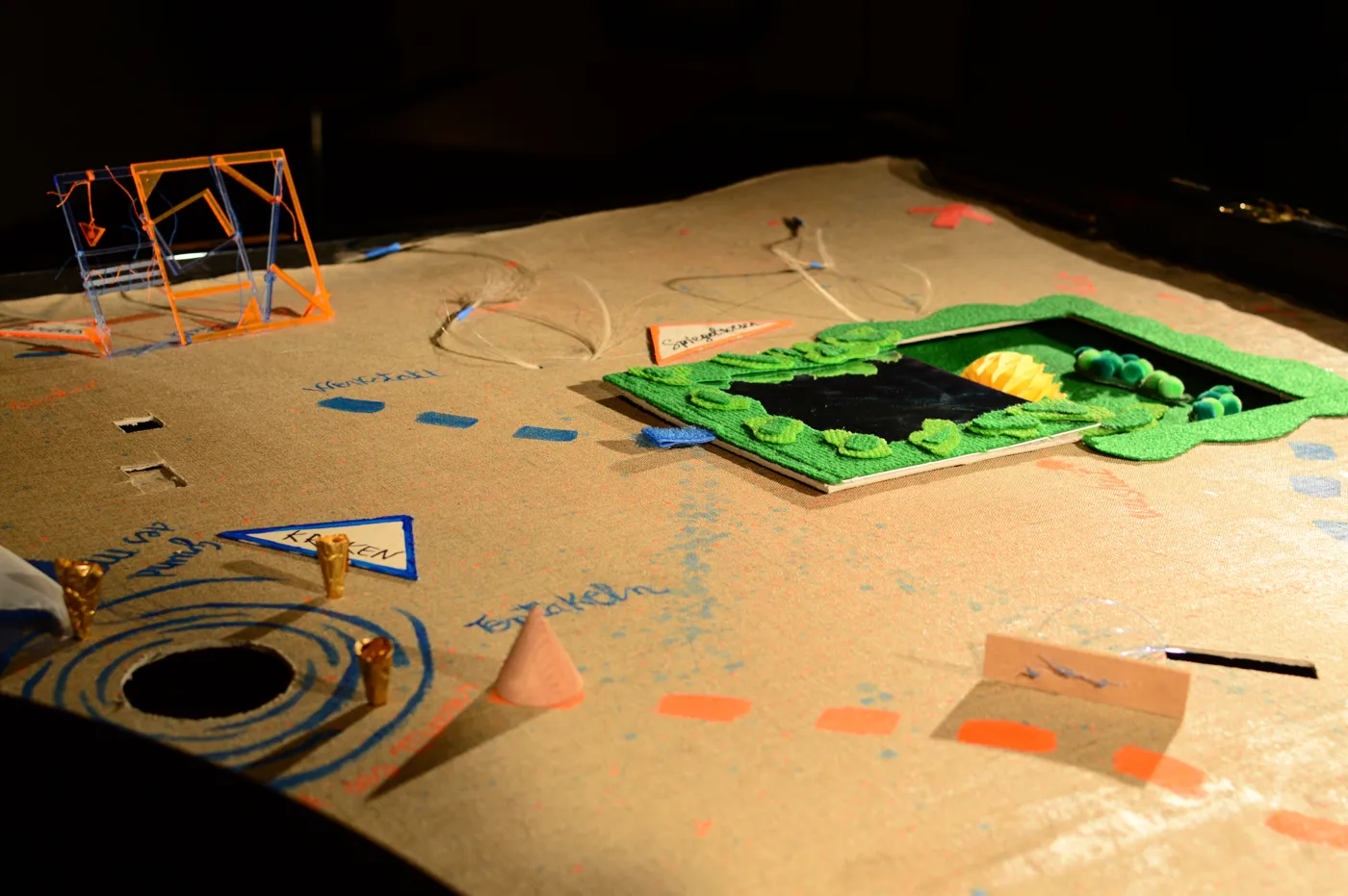
An interactive sound walk for people aged 6 and up
The basement of the HKW Berlin (House of World Cultures) has been home to the famous collection of inventor Prof. Dr. Krollimund for centuries. The most valuable exhibit in this collection is an ancient, unique grand piano, the first of its kind. Unfortunately, it no longer plays, as it has been broken for a long time. Or perhaps no one can remember how to play it anymore. When visitors, guided by a HKB employee, enter the room to coat the grand piano, strange noises suddenly emerge from within. The instrument begins to speak and gives the children a task...
This is how Bestiarium begins, a musical theater piece by DieOrdnungDerDinge (Iñigo Giner Miranda, director) and composer Nuria Núñez Hierro. The program combines musical theater, concert, and sound installation in an experimental way, lasts about an hour, and is equally suitable for children (ages six and up) and adults.
Young and old audience members join the musicians on an adventurous journey through the remote department of the HKW, where, even after the death of Dr. Dr. Grolimund, tireless research and experimentation have continued for centuries. There they encounter fantastic creatures whose knowledge they urgently need: in order for the ancient instrument to sound again, the children must ask the creatures for advice and gather the secret knowledge of the various departments. For only children, as proven experts in imagination, will be able to solve this mystery. But this is only possible with the help of a musical enchantment. The strange creatures inhabiting the rooms will teach the children this liberating music, and together they will perform a grand magic concert, bringing the forgotten instrument back to life. The imaginary beings in the show are inspired by mythical creatures, medieval creatures (such as those from the 12th-century Aberdeen Bestiary), but also characters from books by Jules Verne, H. G. Wells, and Lewis Carroll.
The stations in Bestiarium can be described as an interplay of interactive sound space, audiovisual installation, and live classical instruments with expanded possibilities. Each station highlights a basic musical theme, and the tasks for the children vary accordingly: from the precise execution of joint movements to the imitation of sounds to the perception of the finest sounds and their spatial location. The format thus invites children to master challenging situations in a playful way—and to have unexpectedly poetic experiences in the process.
At each station, there is a musician who, as an expert on the respective creature, talks to the audience, guides them, and makes music with them. The instruments: violin, cello, saxophone, horn, and piano.
Un paseo sonoro interactivo para personas a partir de 6 años
En el sótano de la HKW Berlin (Casa de las Culturas del Mundo) se esconde, desde hace siglos, la legendaria colección de la inventora Dra. Dra. Grolimund. Su pieza más preciada: un misterioso piano de cola, antiguo y único en su especie. Sin embargo, hace mucho que ha dejado de sonar. Tal vez esté averiado… o quizá simplemente nadie recuerde ya cómo hacerlo hablar.
Cuando los visitantes, acompañados por una trabajadora del HKW, acceden a la sala para inspeccionar el instrumento, algo inesperado ocurre: el piano comienza a emitir extraños sonidos. Murmullos, crujidos, ecos… hasta que, finalmente, toma la palabra. Y es entonces cuando encomienda a los niños una misión que solo ellos podrán cumplir…
Así comienza Bestiarium, una obra de teatro musical de DieOrdnungDerDinge (Iñigo Giner Miranda, dirección) y la compositora Nuria Núñez Hierro. El programa combina teatro musical, concierto e instalación sonora de forma experimental, dura aproximadamente una hora y es apto tanto para niños (a partir de seis años) como para adultos.
Los espectadores, tanto pequeños como mayores, emprenden junto con los músicos un viaje aventurero por la remota sección del HKW, donde, incluso tras la muerte de la Dra. Dra. Grolimund, se sigue investigando y experimentando incansablemente desde hace siglos. Allí se encuentran con seres fantásticos cuyo conocimiento necesitan urgentemente: para que el antiguo instrumento pueda volver a sonar, los niños deben pedir consejo a los seres y recopilar los conocimientos secretos de los distintos departamentos. Solo los niños, como expertos reconocidos en la imaginación, son capaces de resolver este enigma.
Pero esto solo es posible mediante un hechizo musical. Con la ayuda de los extraños seres que habitan las salas, los niños aprenden esta música liberadora y, al final, interpretan juntos un gran concierto, haciendo sonar de nuevo el instrumento olvidado. La inspiración para los seres proviene de diversas fuentes, por ejemplo criaturas medievales (como las del Bestiario de Aberdeen del siglo XII), pero también de personajes de libros de Julio Verne, H. G. Wells y Lewis Carroll.
Las estaciones de Bestiarium pueden describirse como una interacción entre un espacio sonoro interactivo, una instalación audiovisual e instrumentos clásicos tocados en directo y ampliados en sus posibilidades. Cada estación ilumina un tema musical básico, por lo que las tareas para los niños también son diferentes: desde la ejecución precisa de movimientos conjuntos hasta la imitación de sonidos y la percepción de los sonidos más sutiles y su ubicación espacial. El formato invita así a superar situaciones exigentes de forma lúdica, viviendo experiencias inesperadamente poéticas.
En cada estación hay un músico que, como experto en el ser en cuestión, habla con el público, le da instrucciones y toca con él. La formación: violín, violonchelo, saxofón, trompa y piano.
Ein interaktiver Klangspaziergang für Menschen ab 6 Jahren
Im Keller des Hauses der Kulturen der Welt befindet sich seit Jahrhunderten die berühmte Sammlung der Erfinderin Prof. Dr. Krollimund. Wertvollstes Exponat dieser Sammlung ist ein uralter, besonderer Flügel, der erste seiner Art. Doch leider klingt er nicht mehr, denn er ist schon lange defekt. Oder vielleicht kann sich auch einfach niemand mehr daran erinnern, wie er gespielt werden muss. Als die BesucherInnen, geführt von einer Mitarbeiterin des HKBs, den Raum betreten, um den Flügel zu beschichtigen, kommen aus seinem Inneren plötzlich seltsame Geräusche. Das Instrument beginnt zu sprechen und gibt den Kindern einen Auftrag...
So beginnt Bestiarium, ein Musiktheater von DieOrdnungDerDinge (Iñigo Giner Miranda, Regie) und der Komponistin Nuria Núñez Hierro. Das Programm verbindet Musiktheater, Konzert und Klanginstallation auf experimentelle Weise, dauert ca. eine Stunde und ist gleichermaßen geeignet für Kinder (ab ca. sechs Jahren) und Erwachsene.
Die kleinen und großen Zuschauerinnen unternehmen gemeinsam mit den Musikerinnen eine abenteuerliche Reise durch die entlegene Abteilung des HKW, in der auch nach dem Tod von Frau Dr. Dr. Grolimund seit Jahrhunderten unermüdlich weitergeforscht und experimentiert wird. Dort begegnen sie fantastischen Wesen, deren Wissen dringend gebraucht wird: Damit das uralte Instrument wieder erklingen kann, müssen die Kinder die Wesen um Rat fragen und das geheime Wissen der verschiedenen Abteilungen sammeln. Denn nur Kinder sind, als ausgewiesene Expert*innen der Phantasie, in der Lage, dieses Rätsel zu lösen.
Das ist aber nur durch eine magische Zaubermusik möglich. Mit Hilfe der seltsamen Wesen, die die Räume bewohnen, erlernen die Kinder diese erlösende Musik, führen am Ende gemeinsam ein großes Zauberkonzert auf und bringen so das vergessene Instrument wieder zum Klingen. Inhaltliche Inspiration sind Fabelwesen, mittelalterliche Kreaturen (wie z. B. aus dem Aberdeen Bestiarium des 12. Jahrhunderts), aber auch Figuren aus Büchern von Jules Verne, H. G. Wells und Lewis Carroll.
Die Stationen in Bestiarium lassen sich als ein Zusammenspiel aus interaktivem Klangraum, audiovisueller Installation und live gespielten, in ihren Möglichkeiten erweiterten klassischen Instrumenten beschreiben. Jede Station beleuchtet ein musikalisches Grundthema – dementsprechend unterschiedlich sind auch die Aufgaben für die Kinder: vom präzisen Ausführen gemeinsamer Bewegungen über das Imitieren von Geräuschen bis hin zur Wahrnehmung feinster Klänge und ihrer räumlichen Verortung.
An jeder Station gibt es einen Musikerin, derdie als Expertin für das jeweilige Wesen mit dem Publikum spricht, es anleitet und gemeinsam mit ihm musiziert. Die Besetzung: Geige, Cello, Saxofon, Horn und Klavier.
Das Format lädt dazu ein, anspruchsvolle Situationen spielerisch zu meistern – und dabei unerwartet poetische Erfahrungen zu machen.
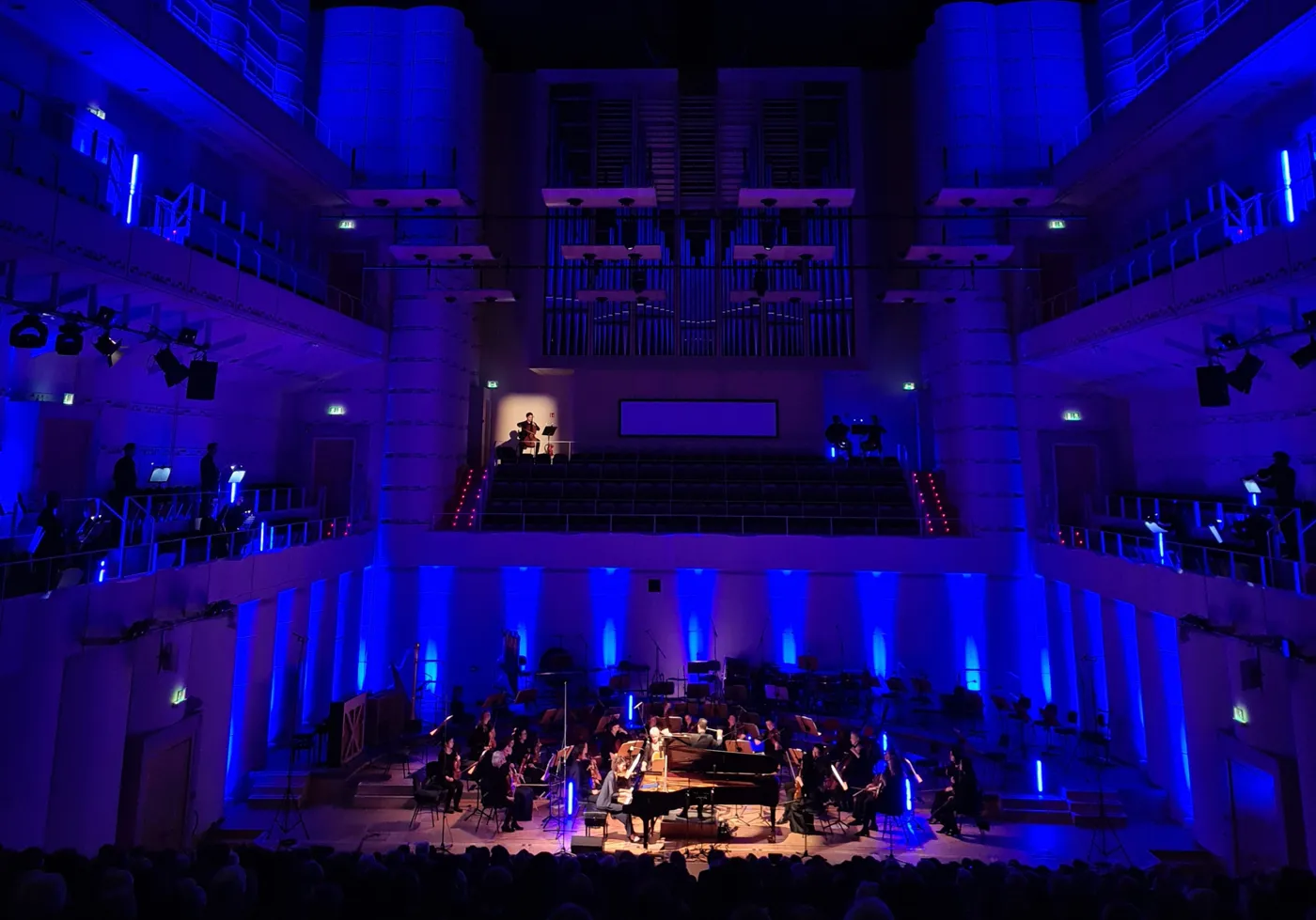
Dortmund Konzerthaus – January 27, 2023
Co-production with the WDR Symphony Orchestra / Conductor: Miguel Pérez Iñesta / Dramaturgy: Guillem Borràs
This concert, which was originally conceived for the Konzerthaus Dortmund in collaboration with the WDR Symphony Orchestra, is dedicated exclusively to female composers of the 19th and 20th centuries.
The program that night included works by Maria Bach, Grażyna Bacewicz, Augusta Holmès, Elizabeth Maconchy, Germaine Tailleferre, Clara Schumann, Rebecca Clarke, Amy Beach, and Fanny Hensel, but it's actually easily. adaptable
More than just a musical anthology, the concert offers a narrative journey through the lives and experiences of these women who composed in strongly male-dominated contexts. A selection of short texts, written by the composers themselves, family members, or music critics, introduces each piece with biographical details, anecdotes, or commentary, providing a more personal perspective while also creating space for reflection on the role of women in music history and the processes through which we decide which works and individuals have the “right” to be included in music history. The aim was to create a context that encourages listening without distracting, while introducing some of these little-known women and allowing a more personal access to their works.
The staging is deliberately understated: subtle lighting that underscores the musical atmosphere creates a sober visual presence that focuses on the music and the text. The aim here is not to turn the concert into a visual experience, but to create the conditions for the story—that of these often marginalized female composers—to take center stage.
The project thus proposes an alternative form of symphonic programming: not as historical revision or symbolic reparation, but as an invitation to listen from a different perspective; to discover and create space for works that are rarely heard on the usual stages – perhaps a different way of telling the history of music.
The concert was also performed in a different version with the Tonhalle Zurich.
“The best thing about this evening – apart from the music – is the combination of surtitles and spoken texts. […] Together with the name of the composer, her dates and the title of the work, you get just the right amount of information, interspersed with interesting anecdotes.”
— Michael S. Zerban, O-Ton
Am Rande des Lichts
Konzerthaus Dortmund – 27 de enero de 2023
Coproducción con la WDR Sinfonieorchester / Director: Miguel Pérez Iñesta / Dramaturgia: Guillem Borràs
Este concierto, concebido en su primera iteración para el Konzerthaus Dortmund en colaboración con la WDR Sinfonieorchester, está dedicado íntegramente a compositoras de los siglos XIX y XX. El programa, que puede ser variable, incluyó en esta primera versión obras de Maria Bach, Grażyna Bacewicz, Augusta Holmès, Elizabeth Maconchy, Germaine Tailleferre, Clara Schumann, Rebecca Clarke, Amy Beach y Fanny Hensel.
Más allá de ofrecer una antología musical, el concierto propone un recorrido narrativo por las vidas y experiencias de estas mujeres que compusieron en contextos marcadamente masculinos. Una selección de textos breves, tanto de las propias compositoras como de familiares o críticos musicales, introduce cada pieza con datos biográficos, anécdotas o comentarios que facilitan una aproximación más personal a la vez que abren un espacio para la reflexión del rol de las mujeres en la historia de la música, así como de los procesos a través de los cuales decidimos qué obras y personas tienen el "derecho" de integrarse en la historia de la música. El objetivo era dar un contexto que animara a la escucha sin interferir en ella, así como introducir a algunas de estas mujeres, no muy conocidas, y facilitar una aproximación más personal a sus obras.
Los recursos escénicos son deliberadamente discretos: una iluminación medida que acompañaba la atmósfera musical genera una presencia visual sobria, centrada en la música y la palabra. No se busca aquí transformar el concierto en un espectáculo visual, sino crear las condiciones para que el relato —el de estas compositoras a menudo relegadas a los márgenes— pueda ocupar el centro.
El proyecto plantea así una forma alternativa de programación sinfónica: no como revisión histórica ni como acto de reparación simbólica, sino como una invitación a escuchar desde otro ángulo, a descubir, abriendo espacio a obras que rara vez encuentran lugar en los escenarios habituales, y tal vez a una forma diferente de construir el relato de la historia de la música.
El concierto se realizó también en otra versión con la Tonhalle de Zürich.
“Lo más bello de la velada —además de la música— fueron los sobretítulos combinados con los textos hablados. Junto con el nombre de cada compositora, la fecha y el título de la obra, se transmitían aquí otras informaciones con un perfecto equilibrio entre información y narración, enriquecido además con alguna que otra anécdota bien elegida.”
— Michael S. Zerban, O-Ton
Am Rande des Lichts
Konzerthaus Dortmund – 27. Januar 2023
Koproduktion mit dem WDR Sinfonieorchester / Dirigent: Miguel Pérez Iñesta / Dramaturgie: Guillem Borràs
Dieses Konzert, das in seiner ersten Fassung für das Konzerthaus Dortmund in Zusammenarbeit mit dem WDR Sinfonieorchester konzipiert wurde, ist ausschließlich Komponistinnen des 19. und 20. Jahrhunderts gewidmet.
Das Programm, das variabel sein kann, umfasste in dieser ersten Fassung Werke von Maria Bach, Grażyna Bacewicz, Augusta Holmès, Elizabeth Maconchy, Germaine Tailleferre, Clara Schumann, Rebecca Clarke, Amy Beach und Fanny Hensel.
Über eine musikalische Anthologie hinaus bietet das Konzert einen narrativen Streifzug durch das Leben und die Erfahrungen dieser Frauen, die in stark männlich geprägten Kontexten komponierten. Eine Auswahl kurzer Texte, sowohl von den Komponistinnen selbst als auch von Familienangehörigen oder Musikkritikern, leitet jedes Stück mit biografischen Daten, Anekdoten oder Kommentaren ein, die einen persönlicheren Zugang ermöglichen und gleichzeitig Raum für Reflexionen über die Rolle der Frauen in der Musikgeschichte sowie über die Prozesse schaffen, durch die wir entscheiden, welche Werke und Personen das „Recht” haben , in die Musikgeschichte aufgenommen zu werden. Ziel war es, einen Kontext zu schaffen, der zum Zuhören anregt, ohne abzulenken, und gleichzeitig einige dieser wenig bekannten Frauen vorstellt und einen persönlicheren Zugang zu ihren Werken ermöglicht.
Die szenischen Mittel sind bewusst zurückhaltend: Eine dezente Beleuchtung, die die musikalische Atmosphäre unterstreicht, schafft eine nüchterne visuelle Präsenz, die sich auf die Musik und den Text konzentriert. Es geht hier nicht darum, das Konzert in ein visuelles Erlebnis zu verwandeln, sondern die Voraussetzungen dafür zu schaffen, dass die Geschichte – die dieser oft an den Rand gedrängten Komponistinnen – im Mittelpunkt stehen kann.
Das Projekt schlägt somit eine alternative Form der symphonischen Programmgestaltung vor: nicht als historische Revision oder symbolische Wiedergutmachung, sondern als Einladung, aus einem anderen Blickwinkel zuzuhören; zu entdecken und Raum für Werke zu schaffen, die selten auf den üblichen Bühnen zu hören sind – vielleicht eine andere Art, die Geschichte der Musik zu erzählen.
Das Konzert wurde auch in einer anderen Fassung mit der Tonhalle Zürich aufgeführt.
„Das Schönste an diesem Abend – neben der Musik – sind allerdings die Übertitel in Verbindung mit gesprochenen Texten. […] Verbunden mit dem Namen der Komponistin, deren Lebensdaten und dem Titel des Werks, bekommt man hier genau das richtige Maß an Information, in die so manche nette Anekdote eingeflochten ist.“
— Michael S. Zerban, O-Ton

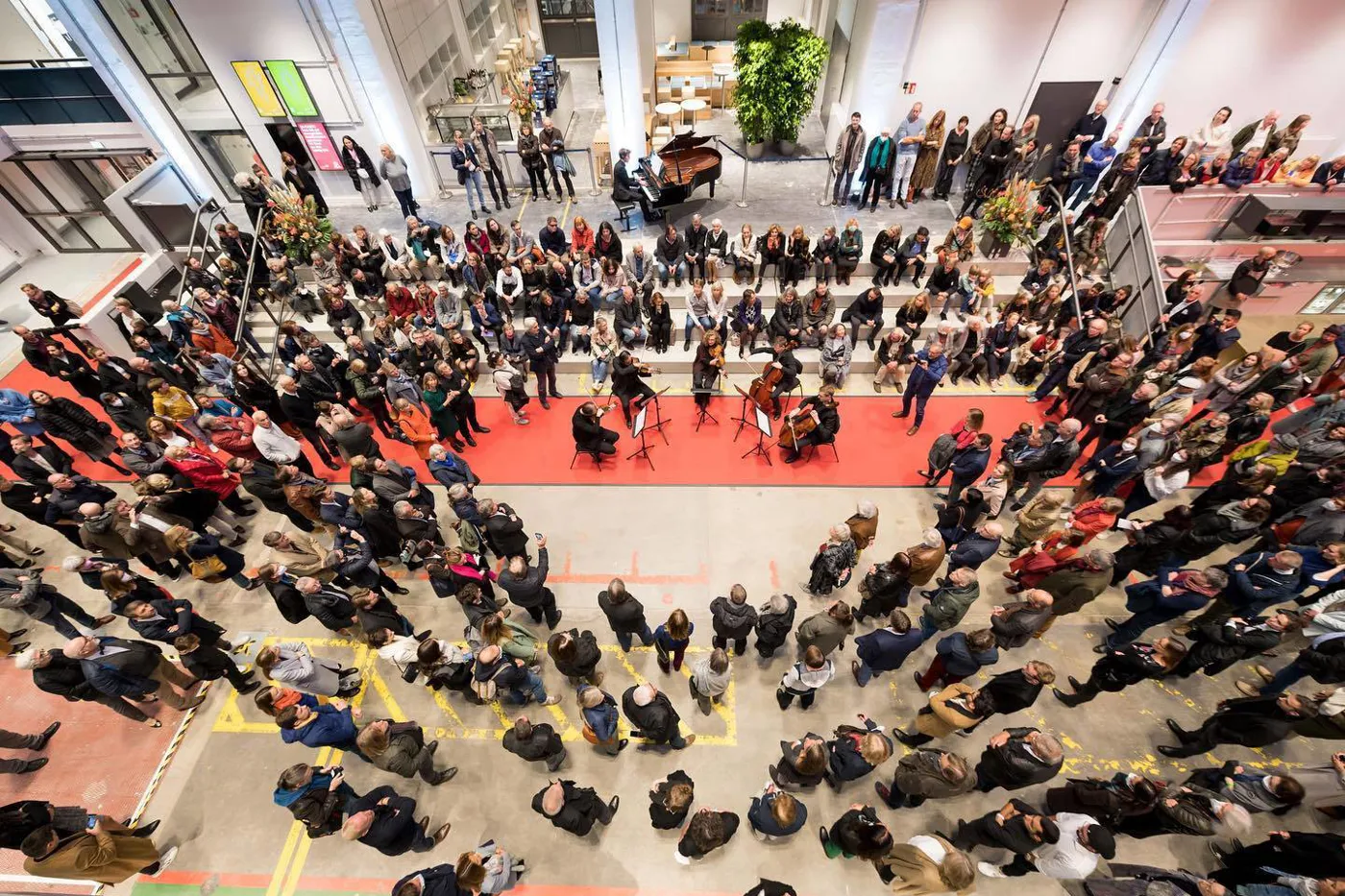
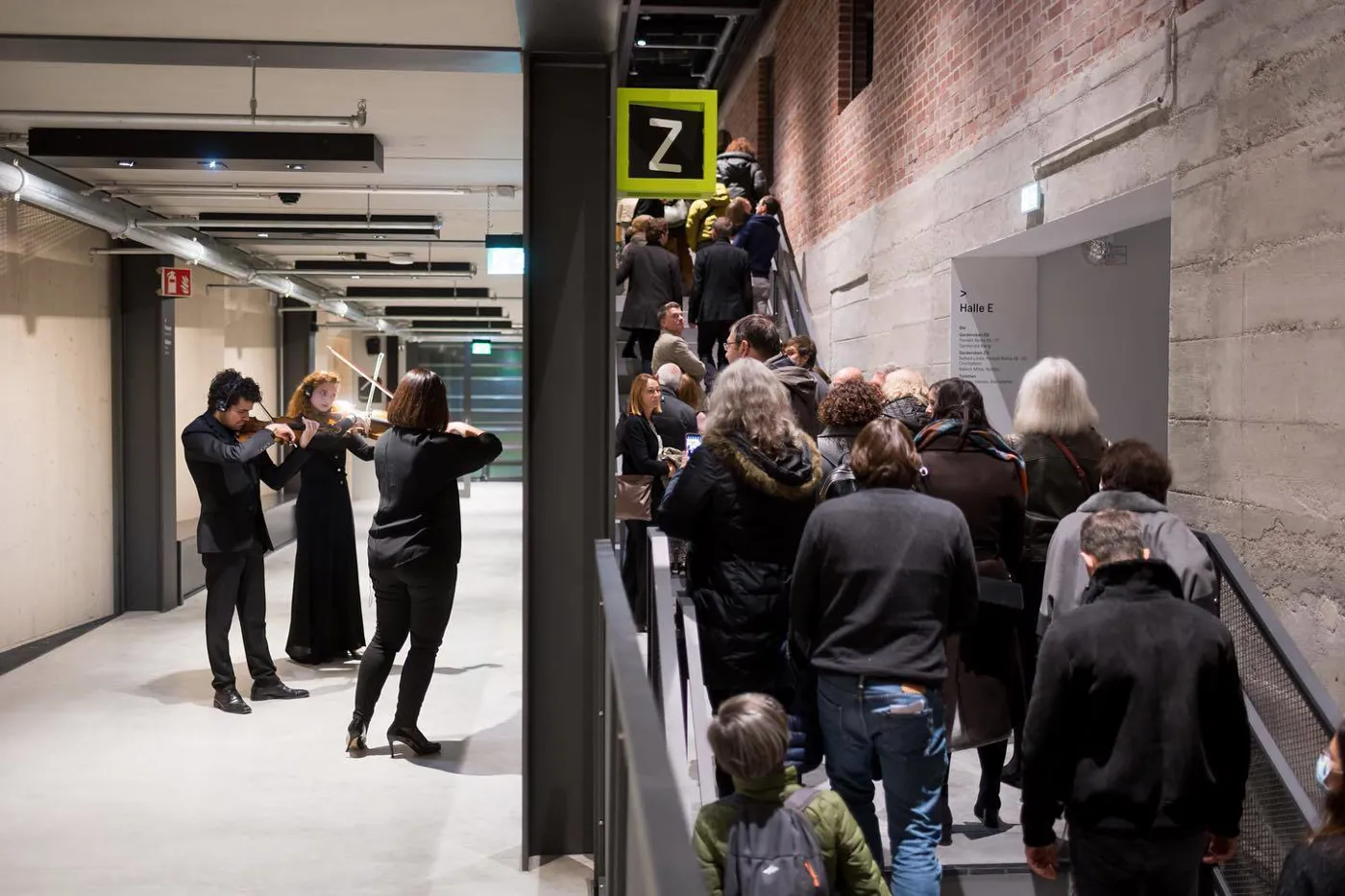

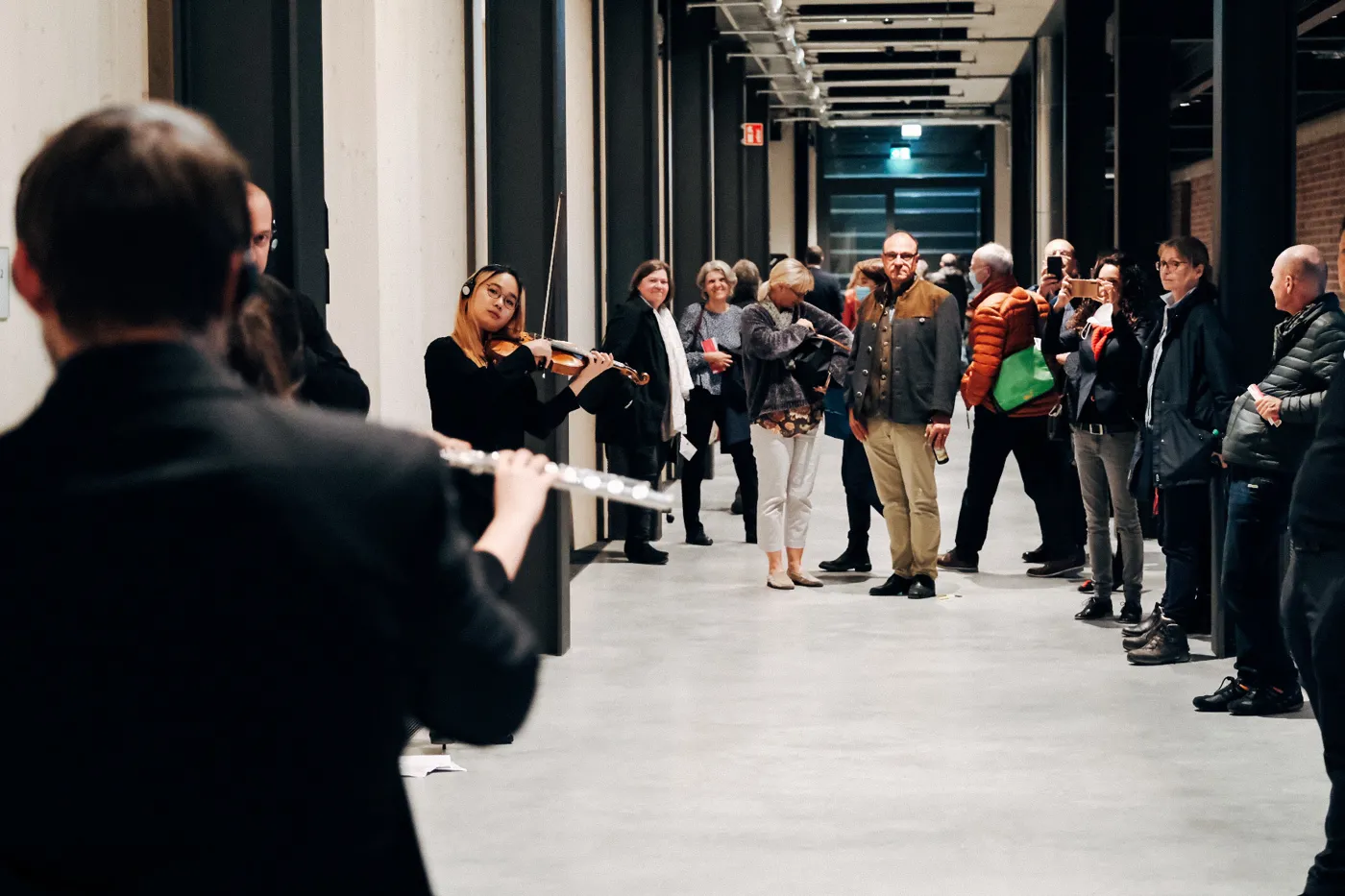
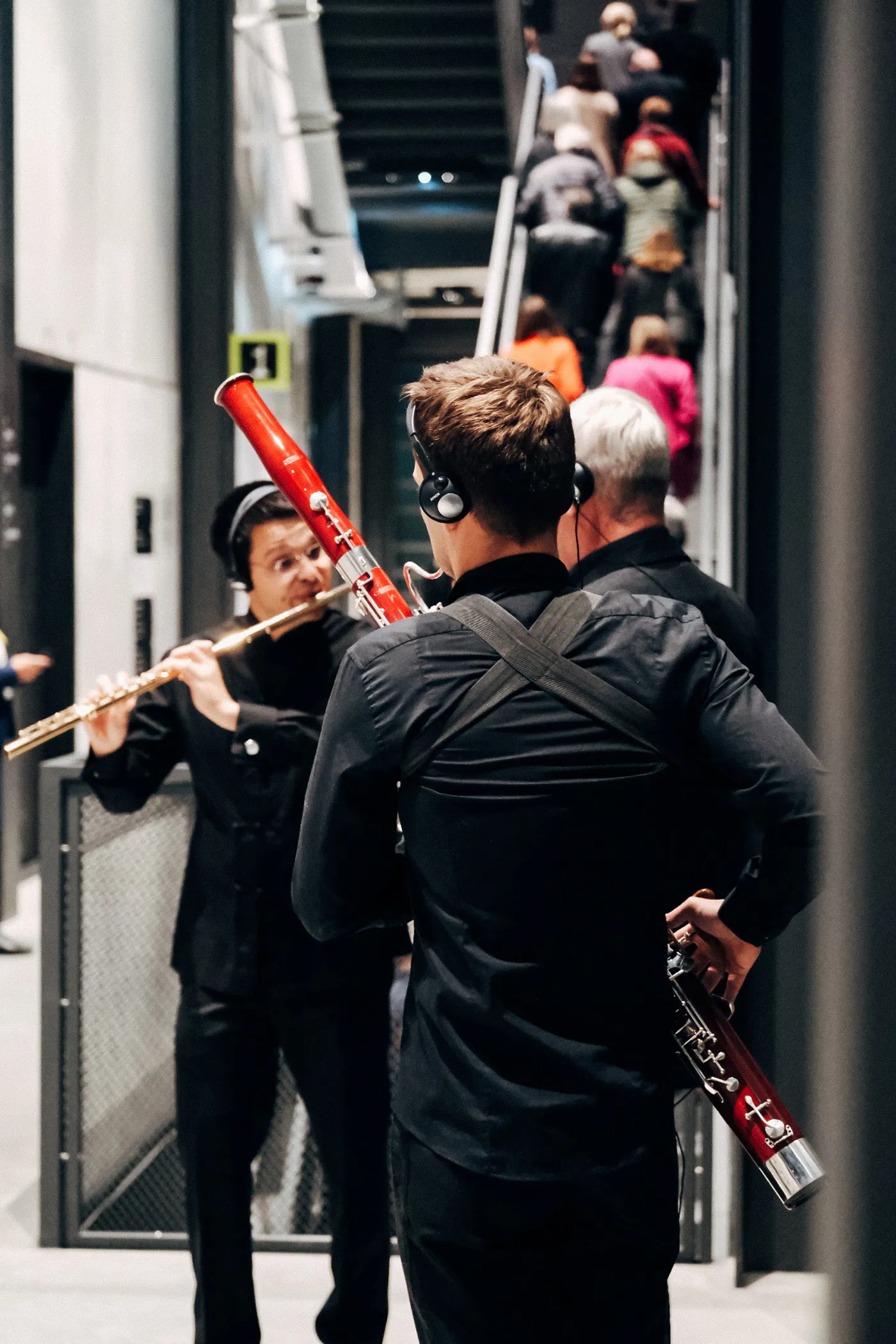

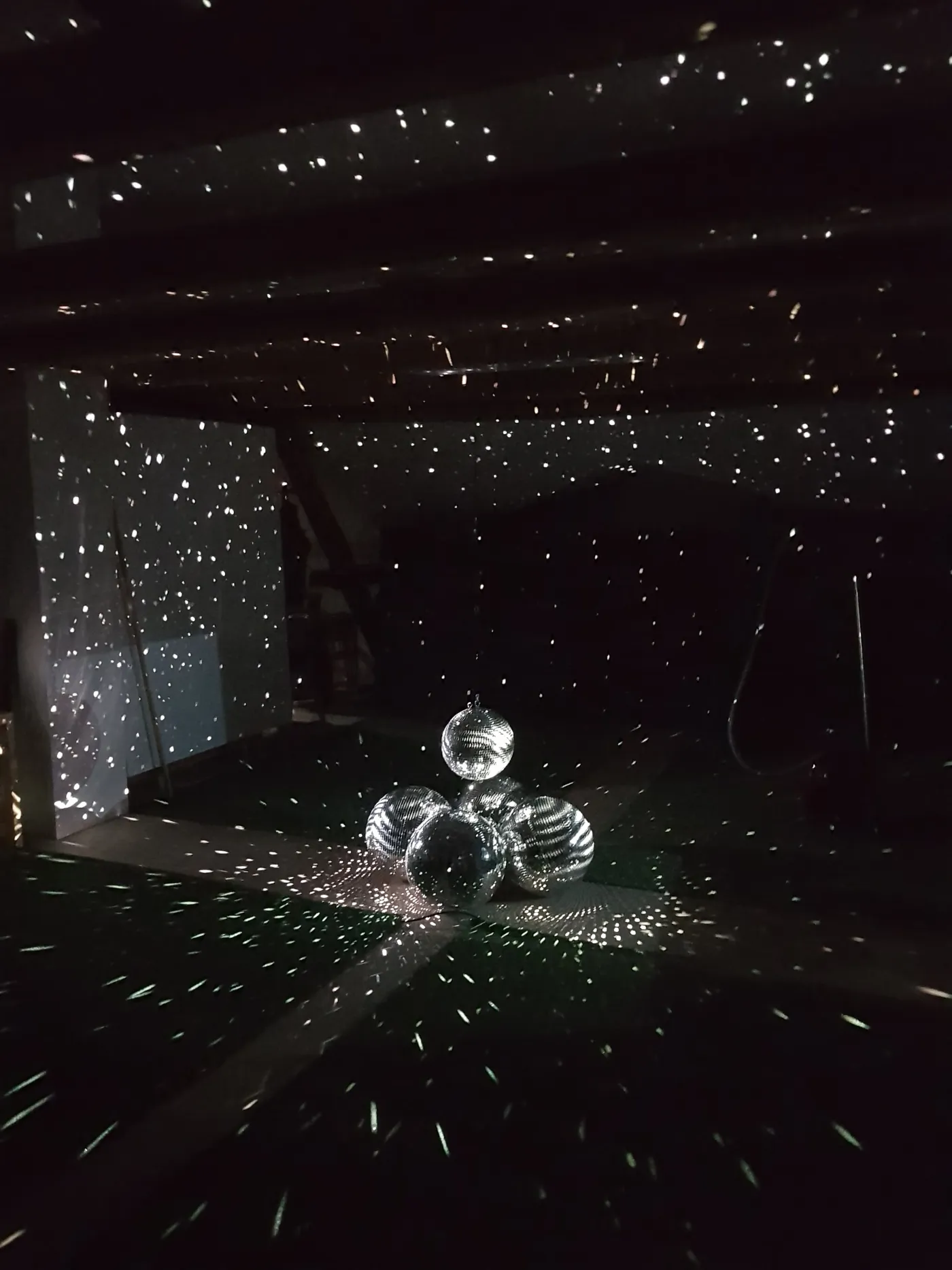
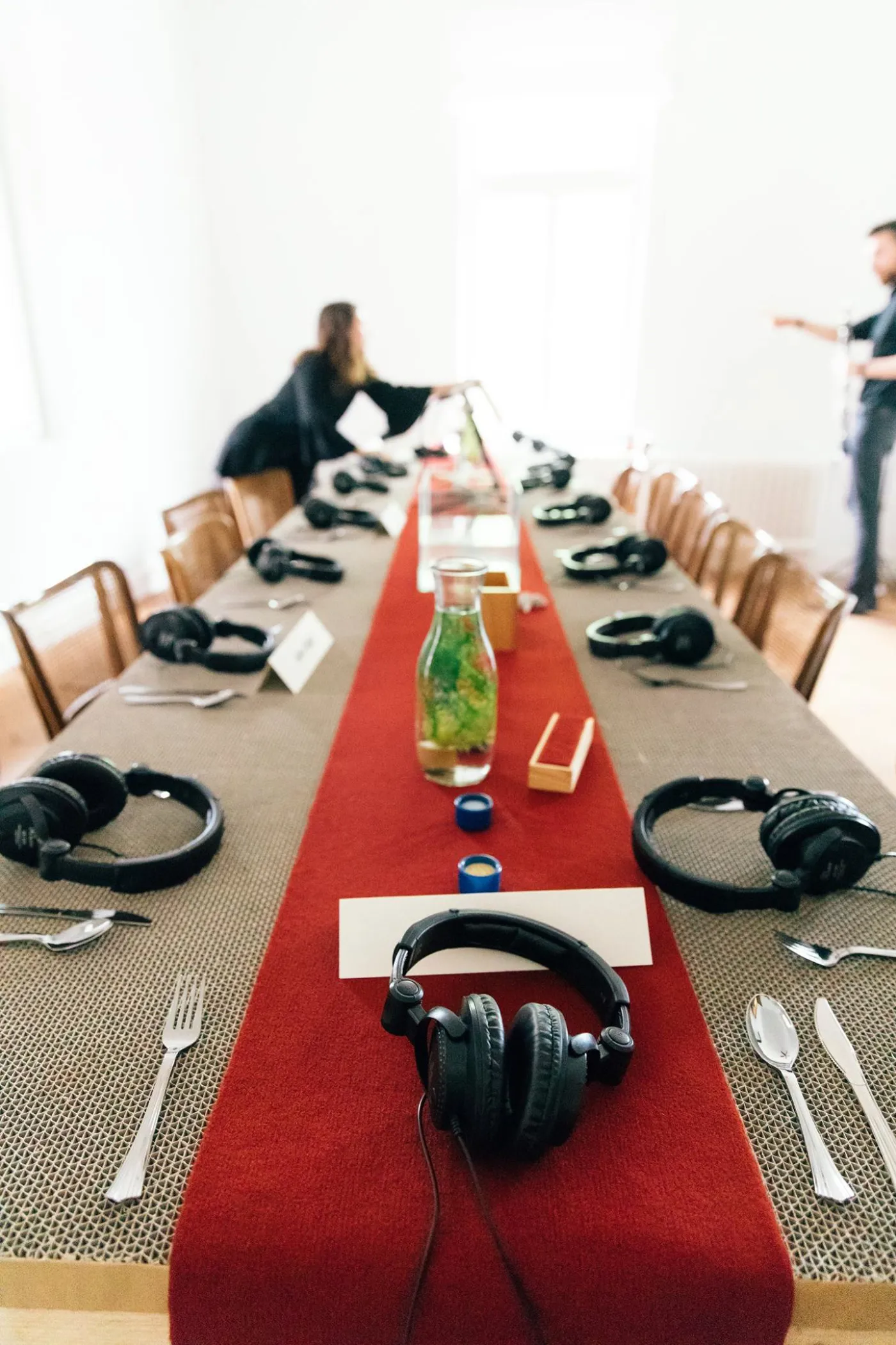
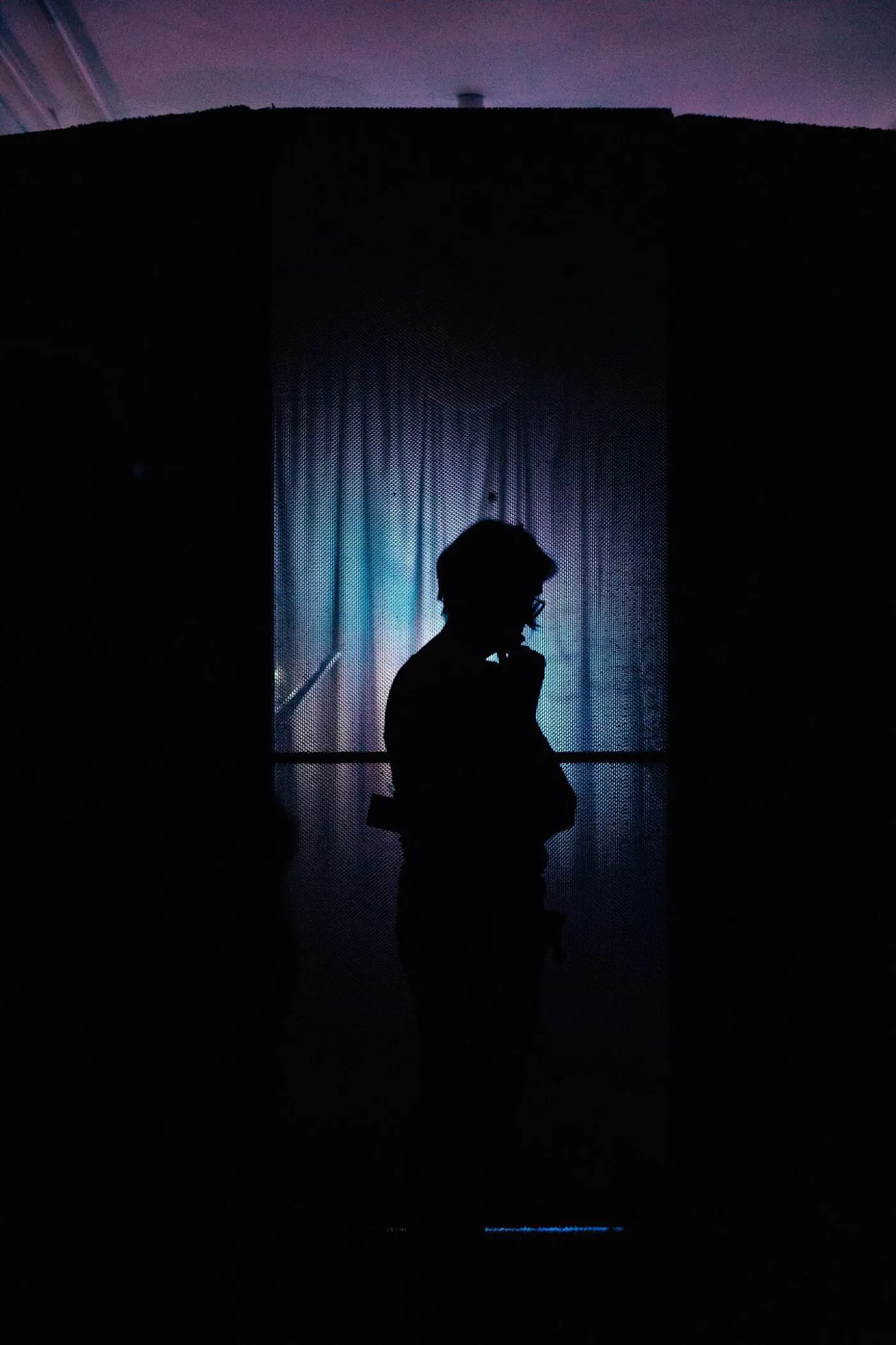
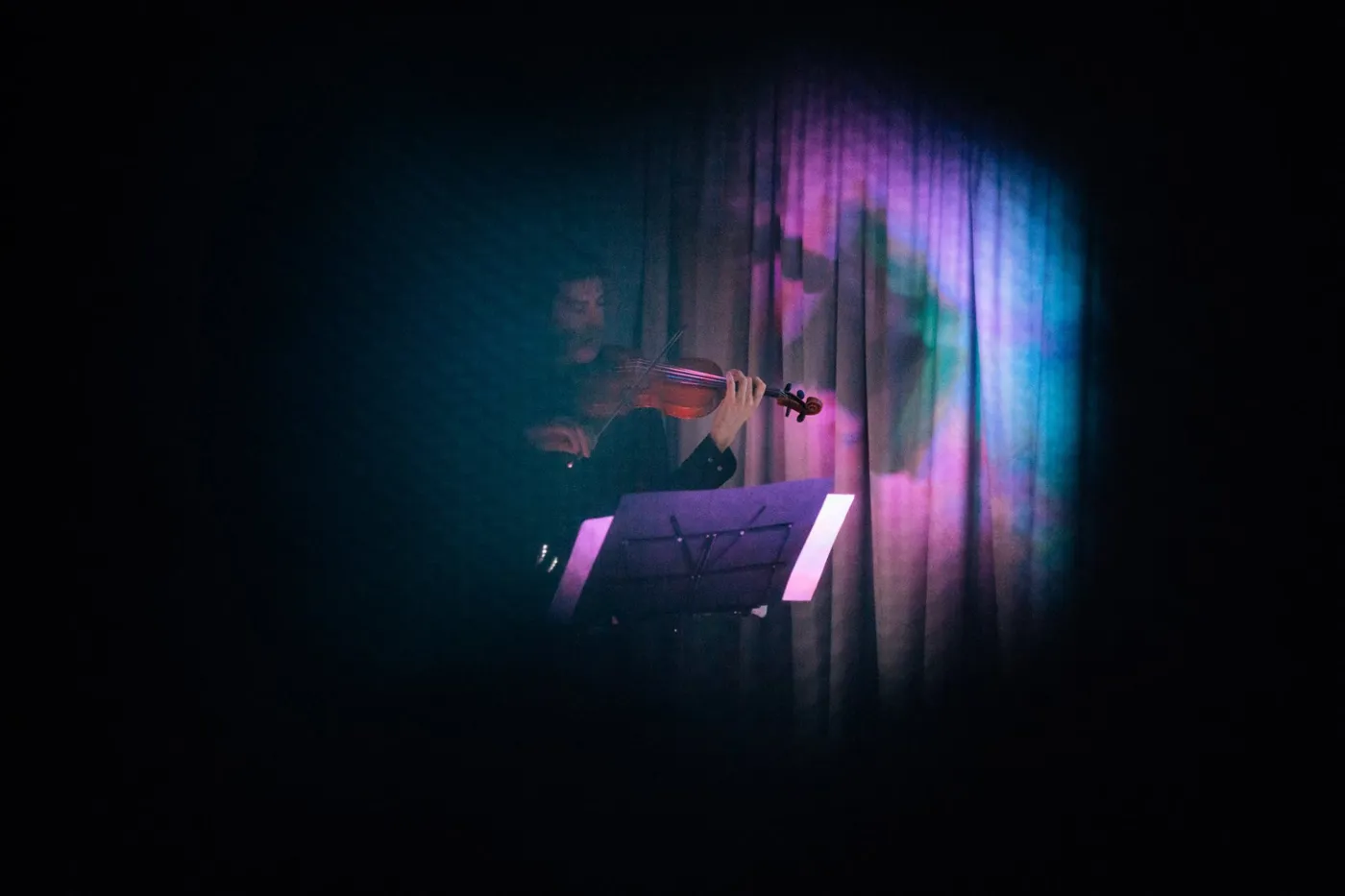
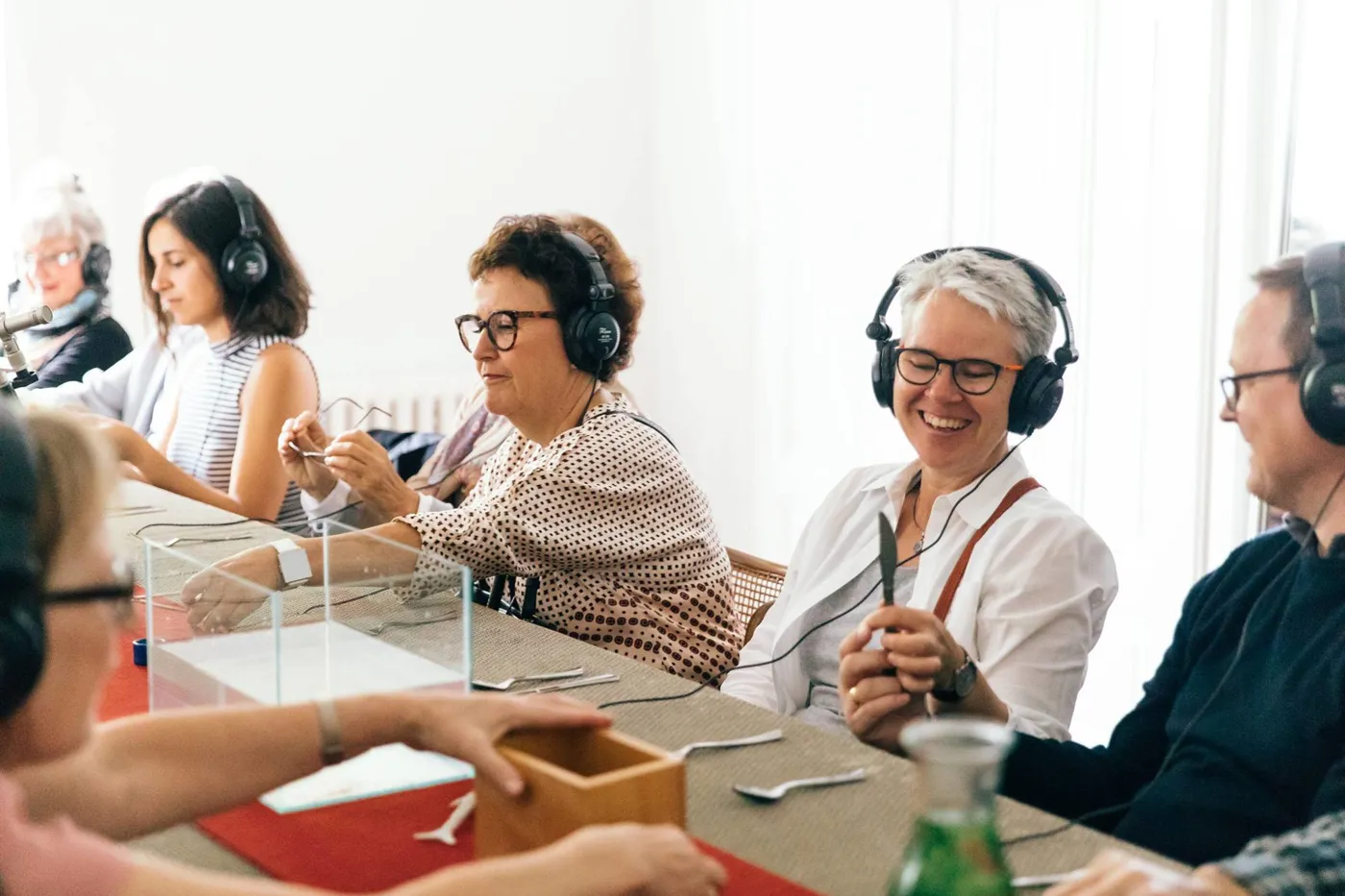
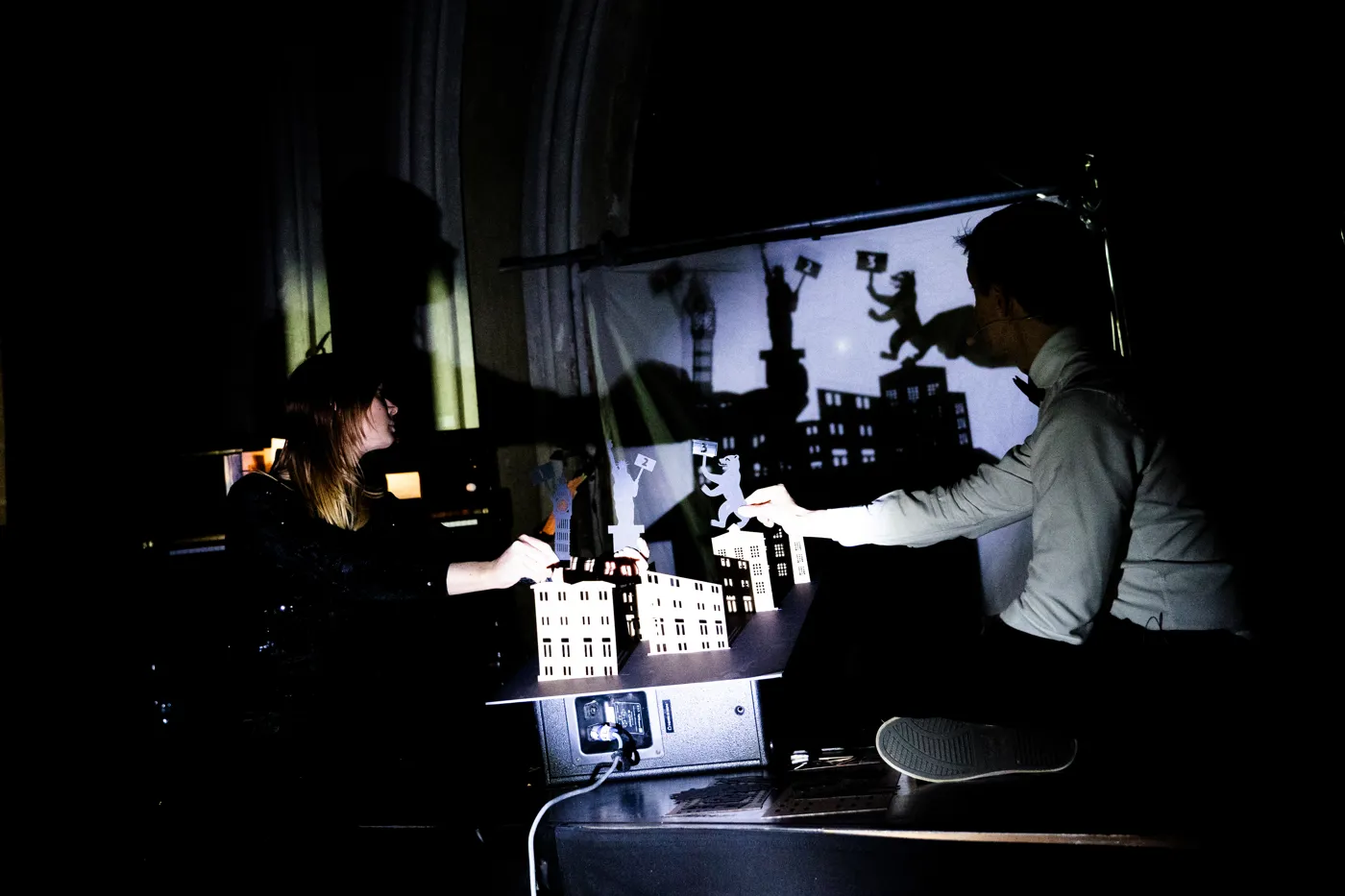
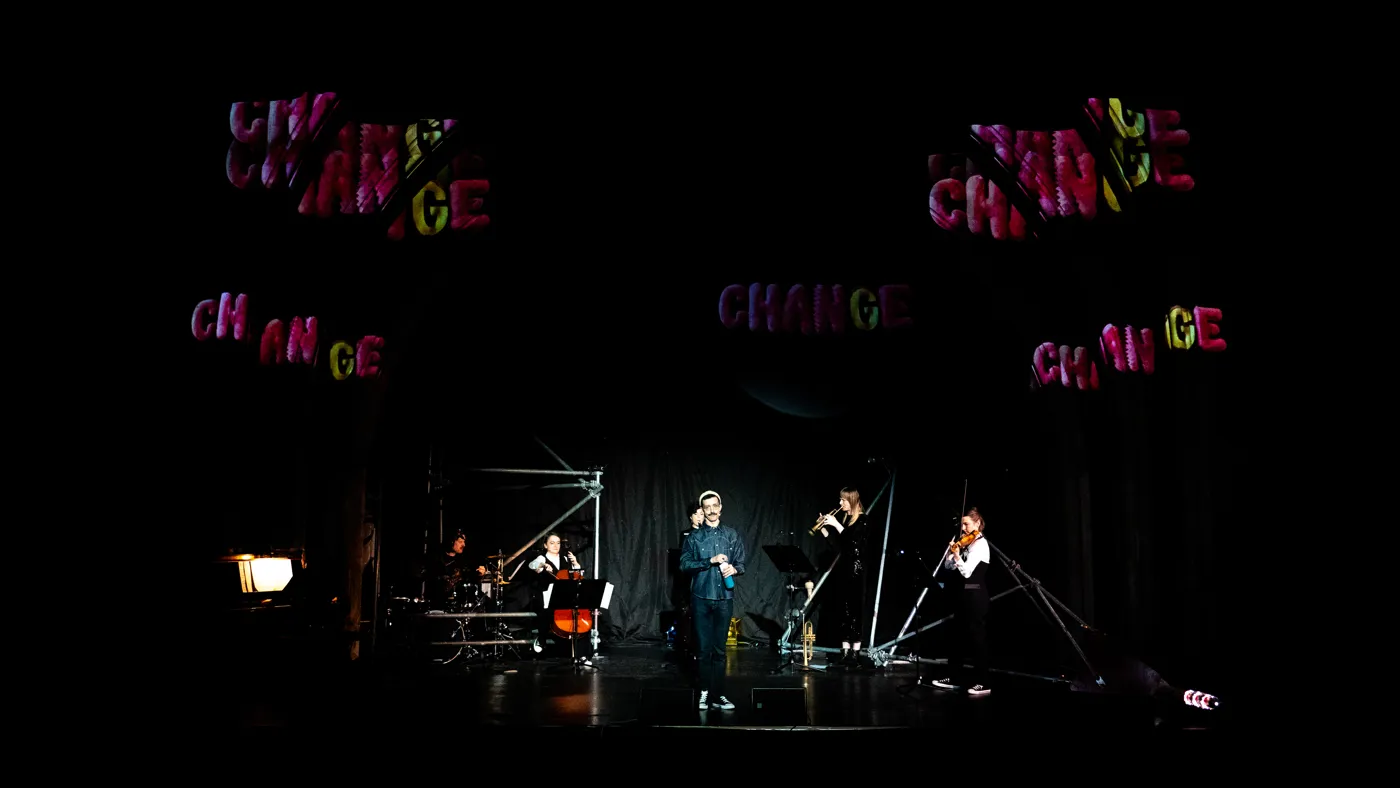
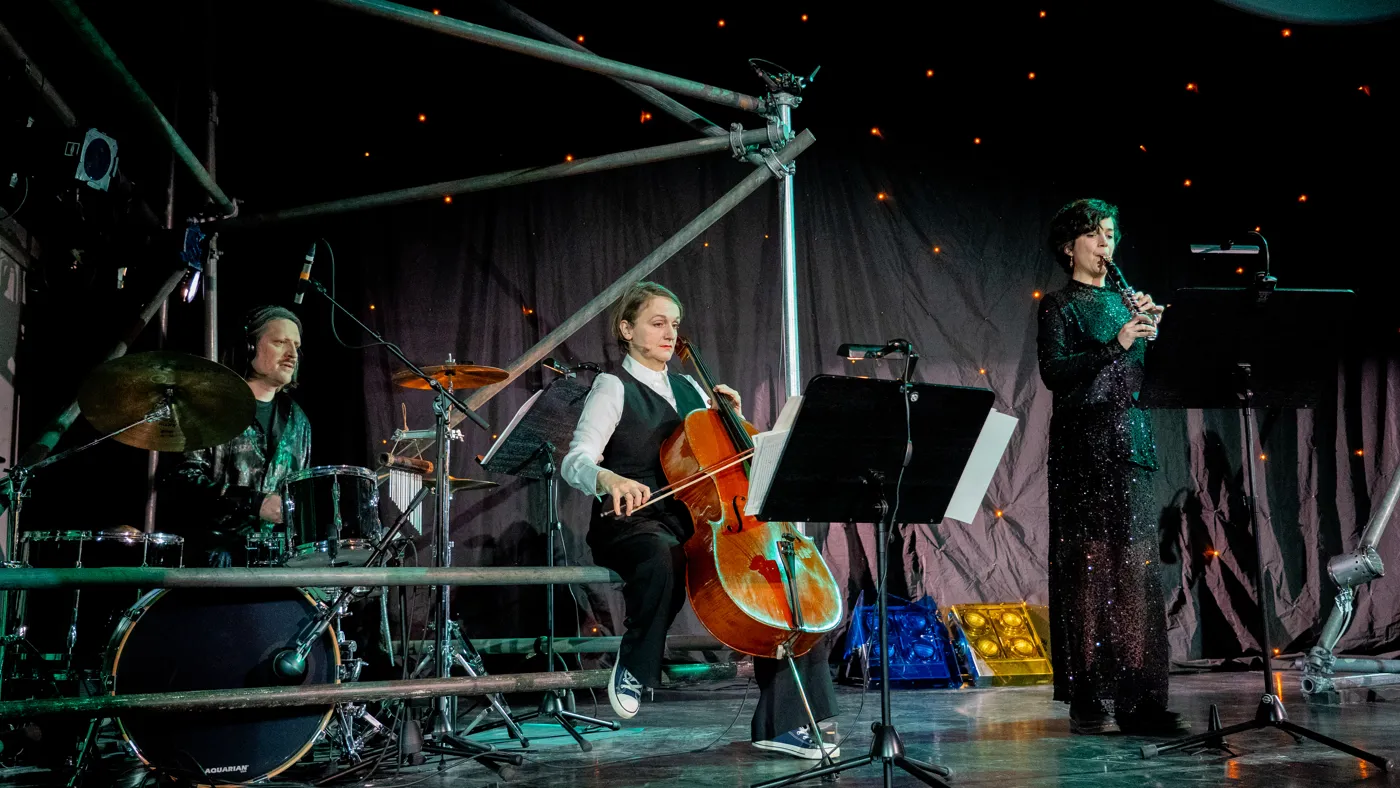
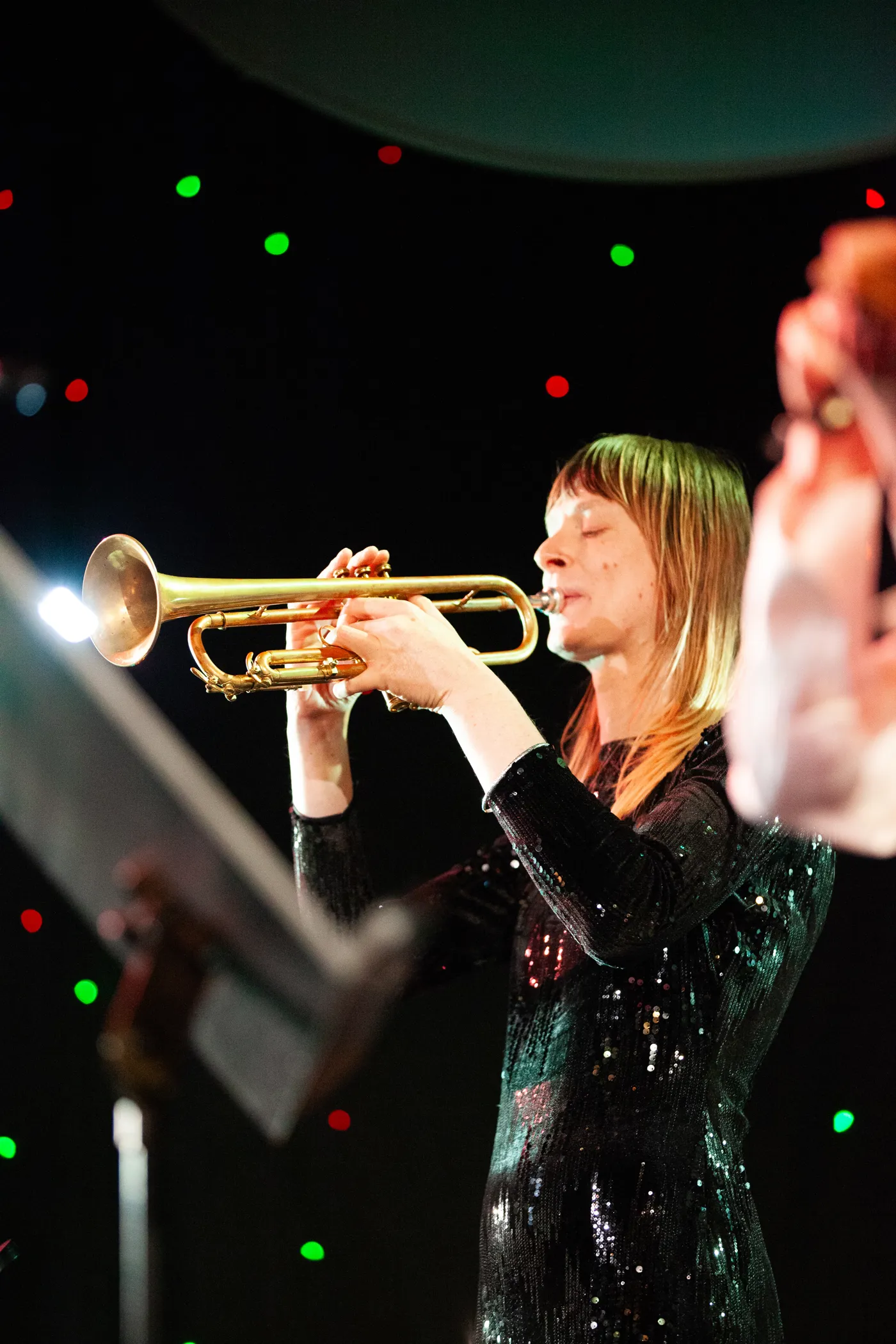
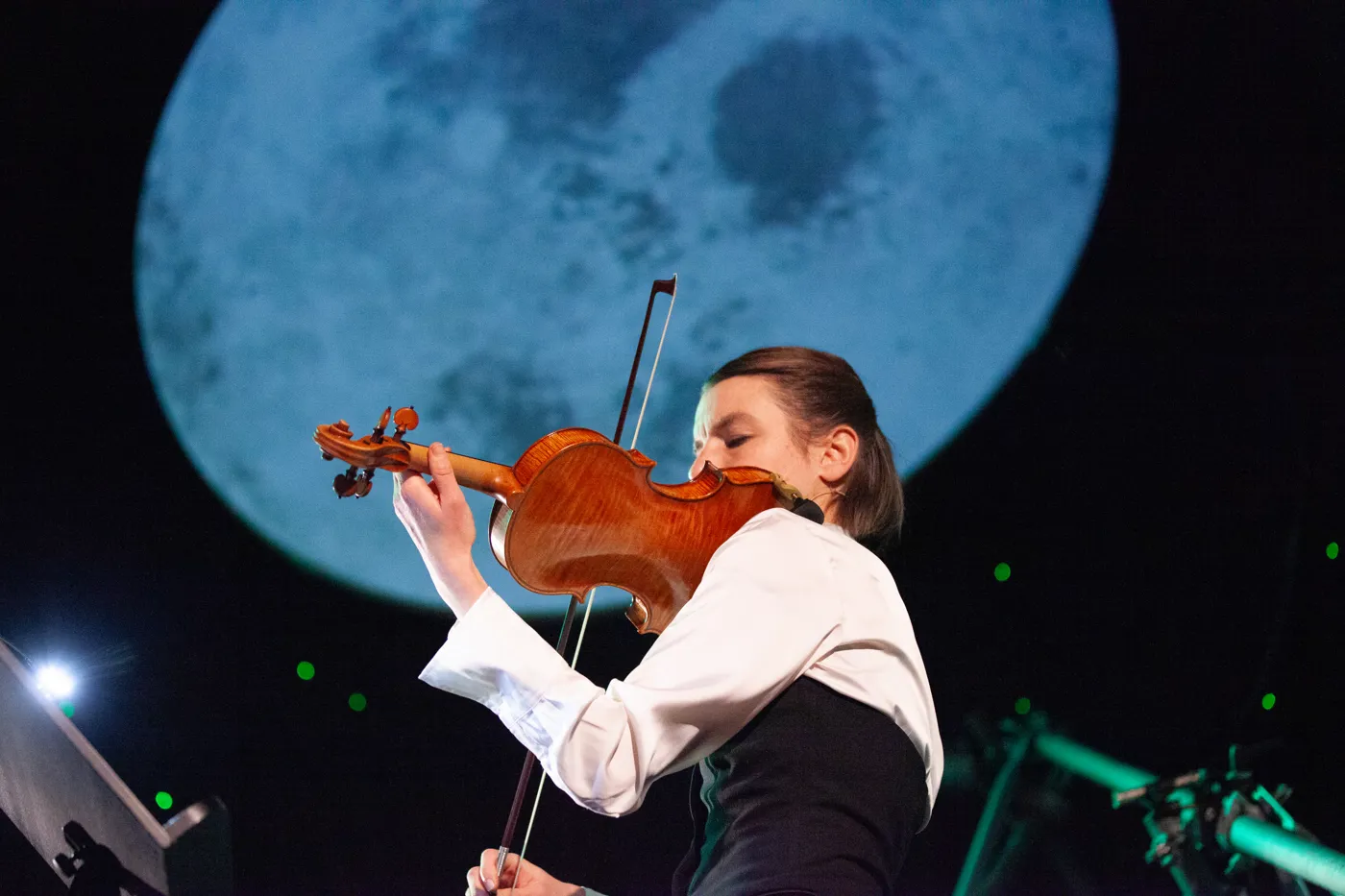

-franzi-kreis-005.webp)
-franzi-kreis-042.webp)
-franzi-kreis-066.webp)
-franzi-kreis-071.webp)

